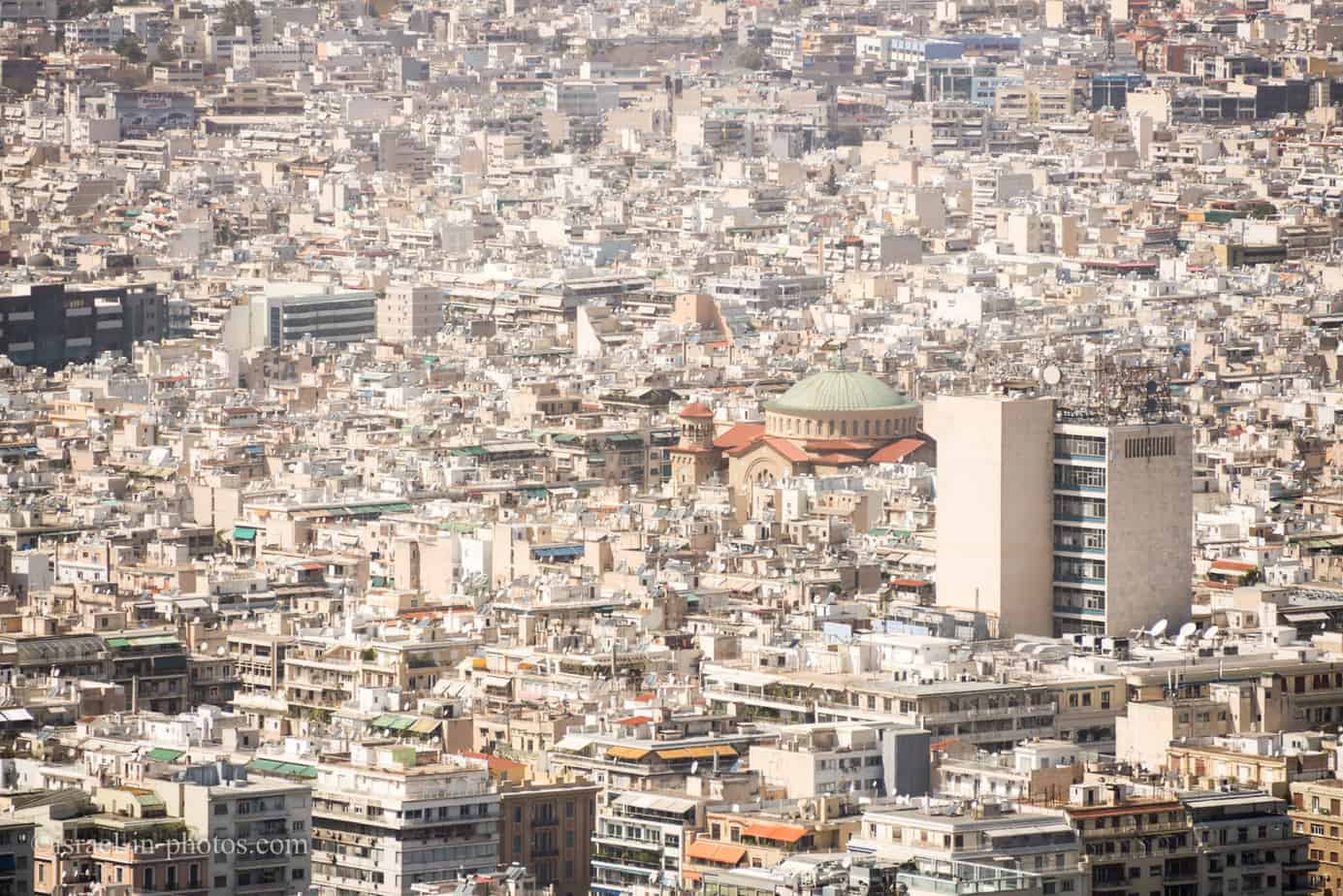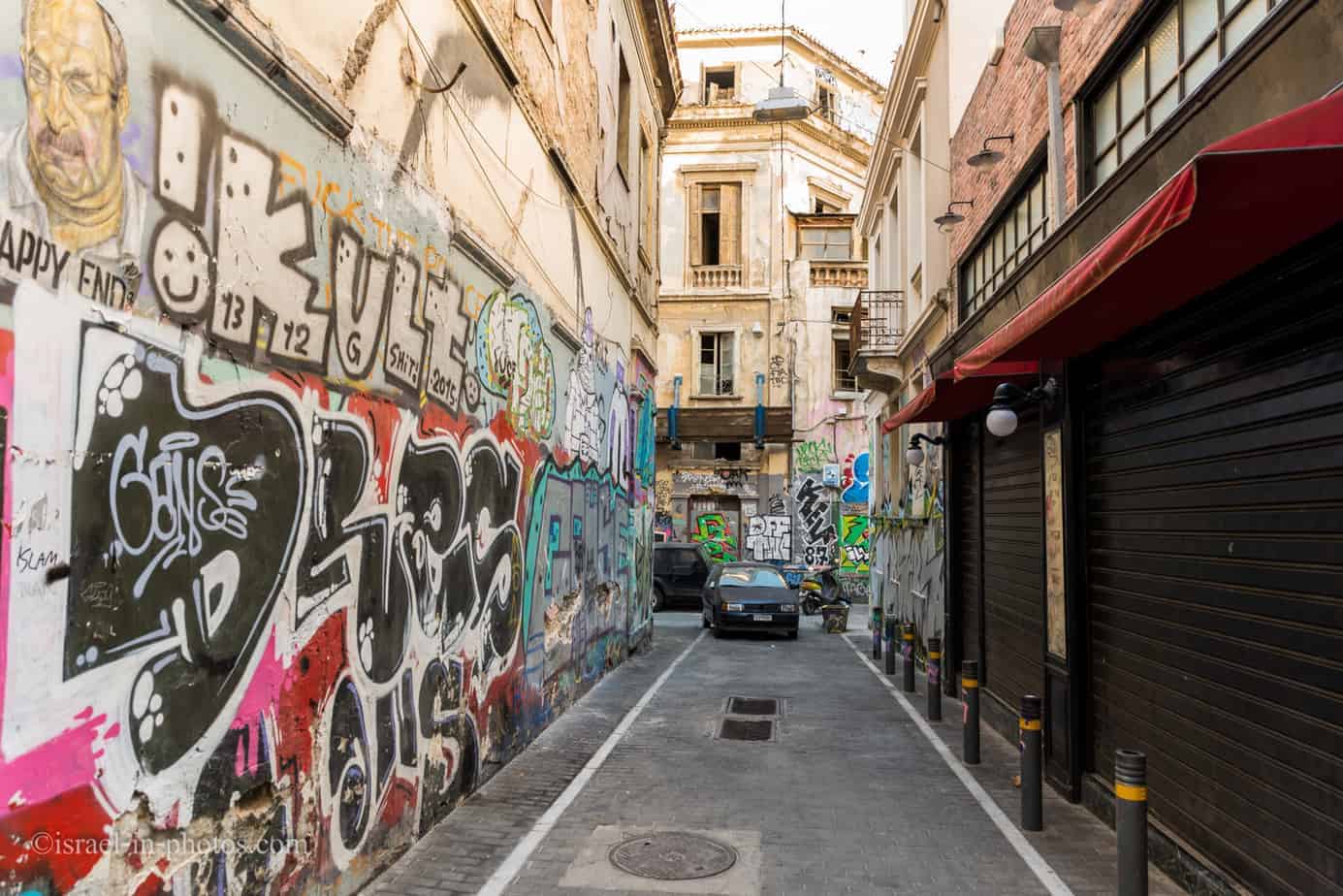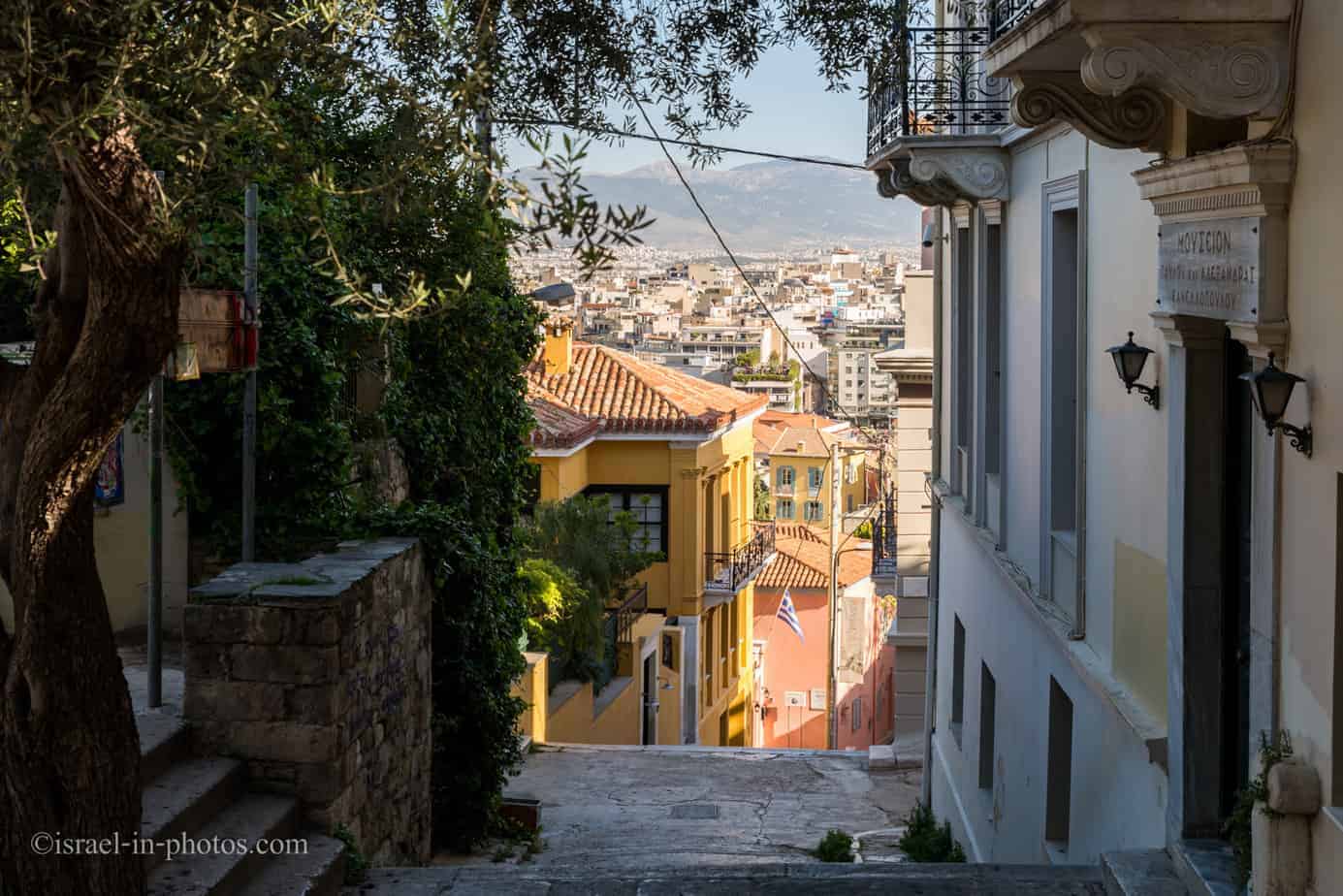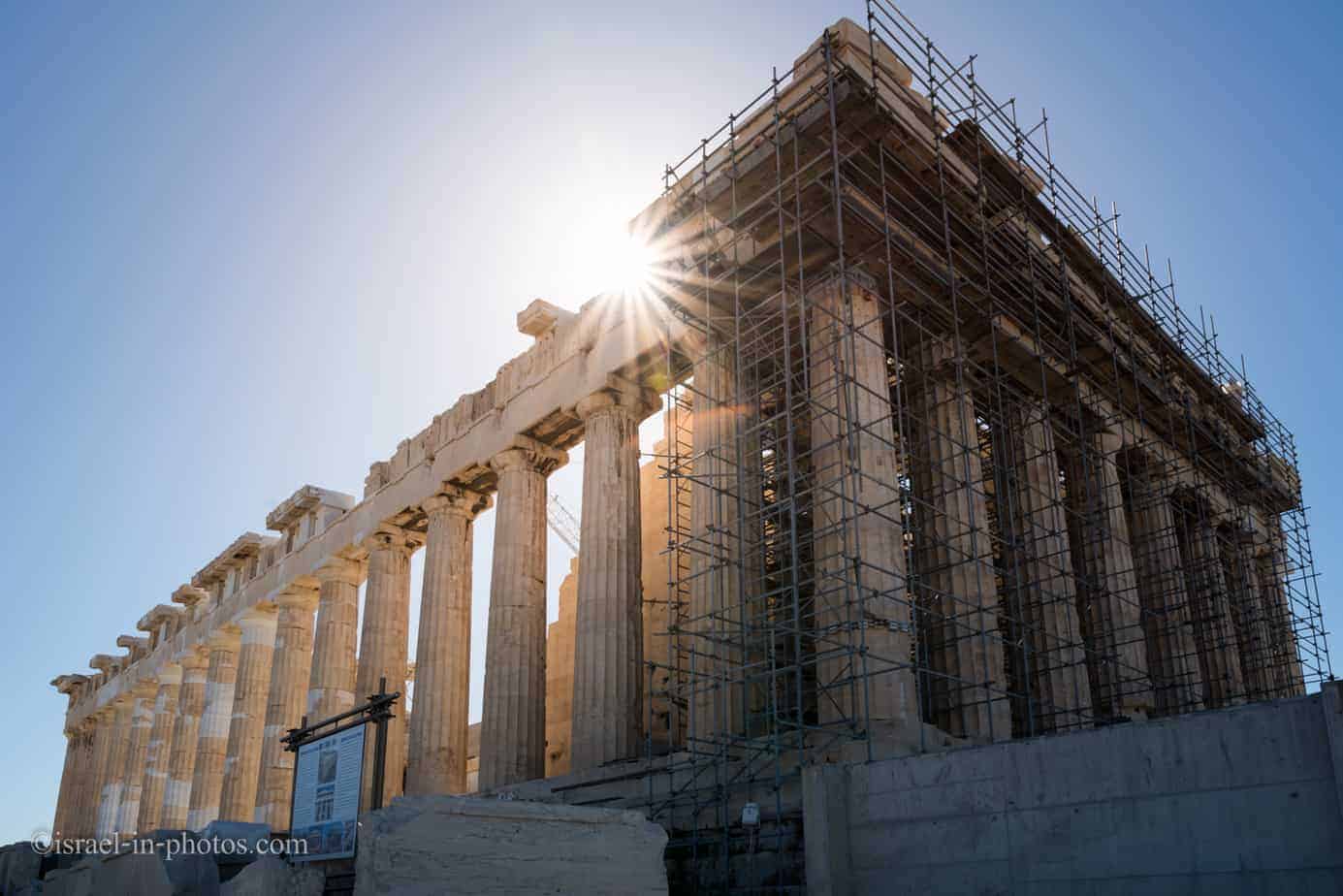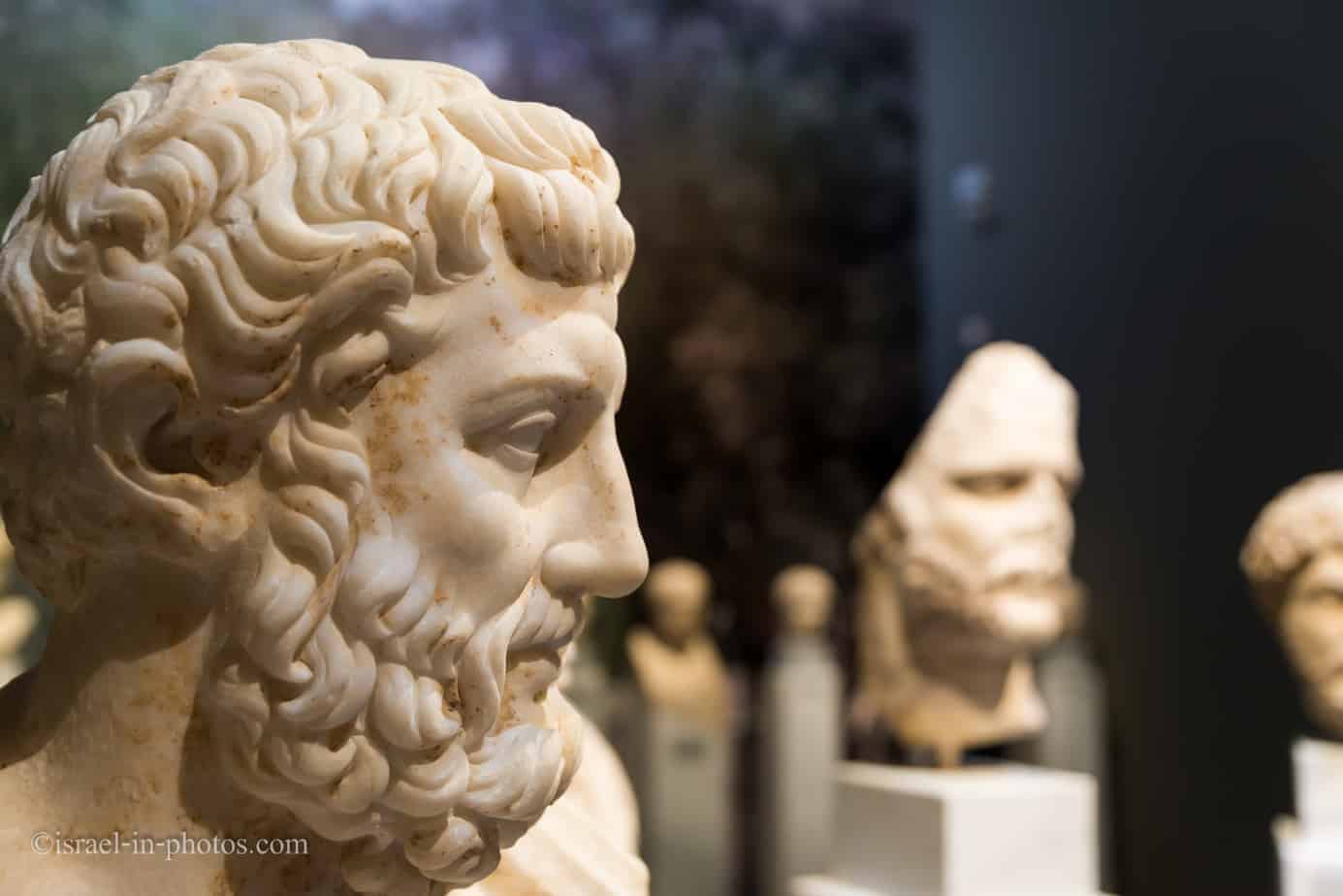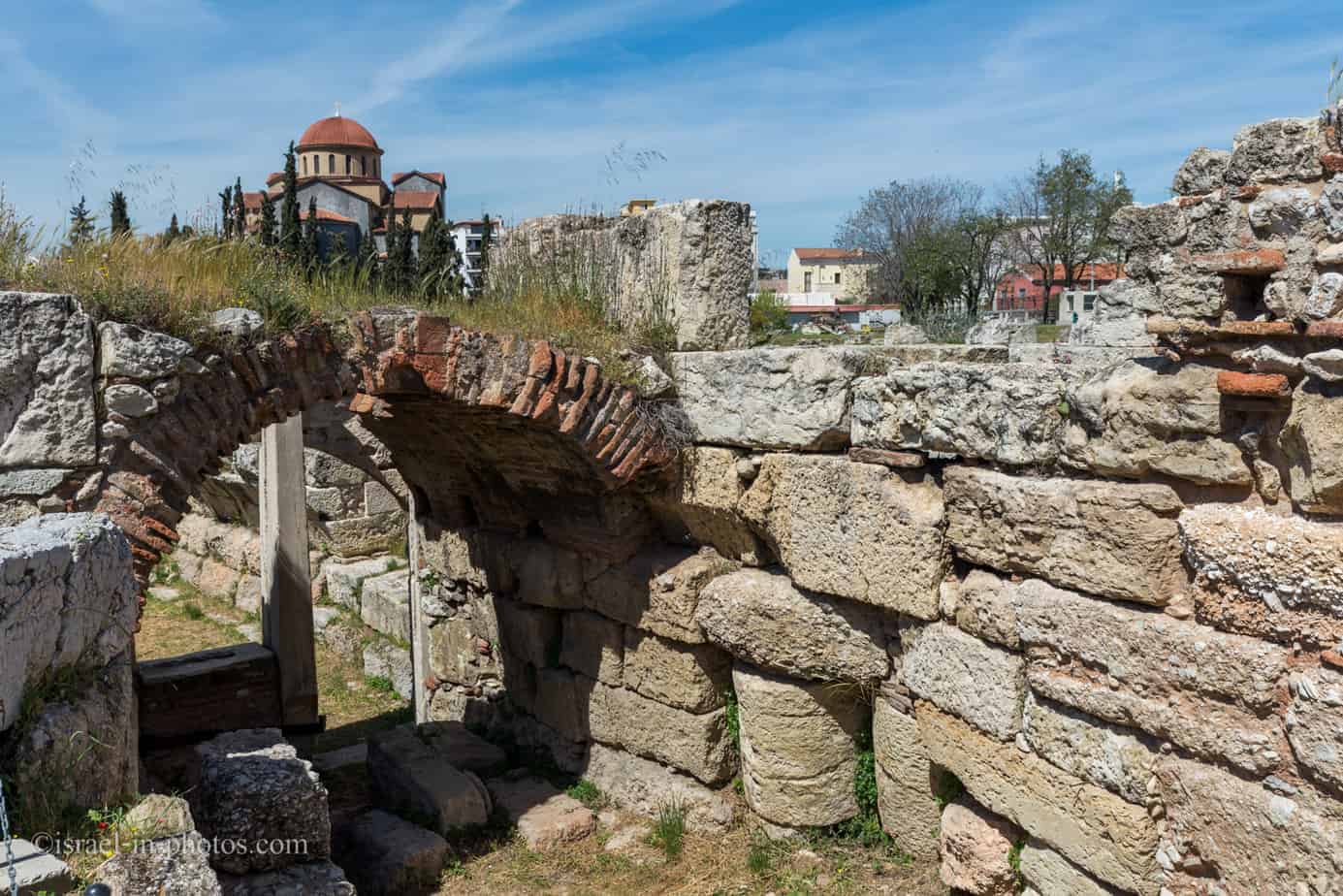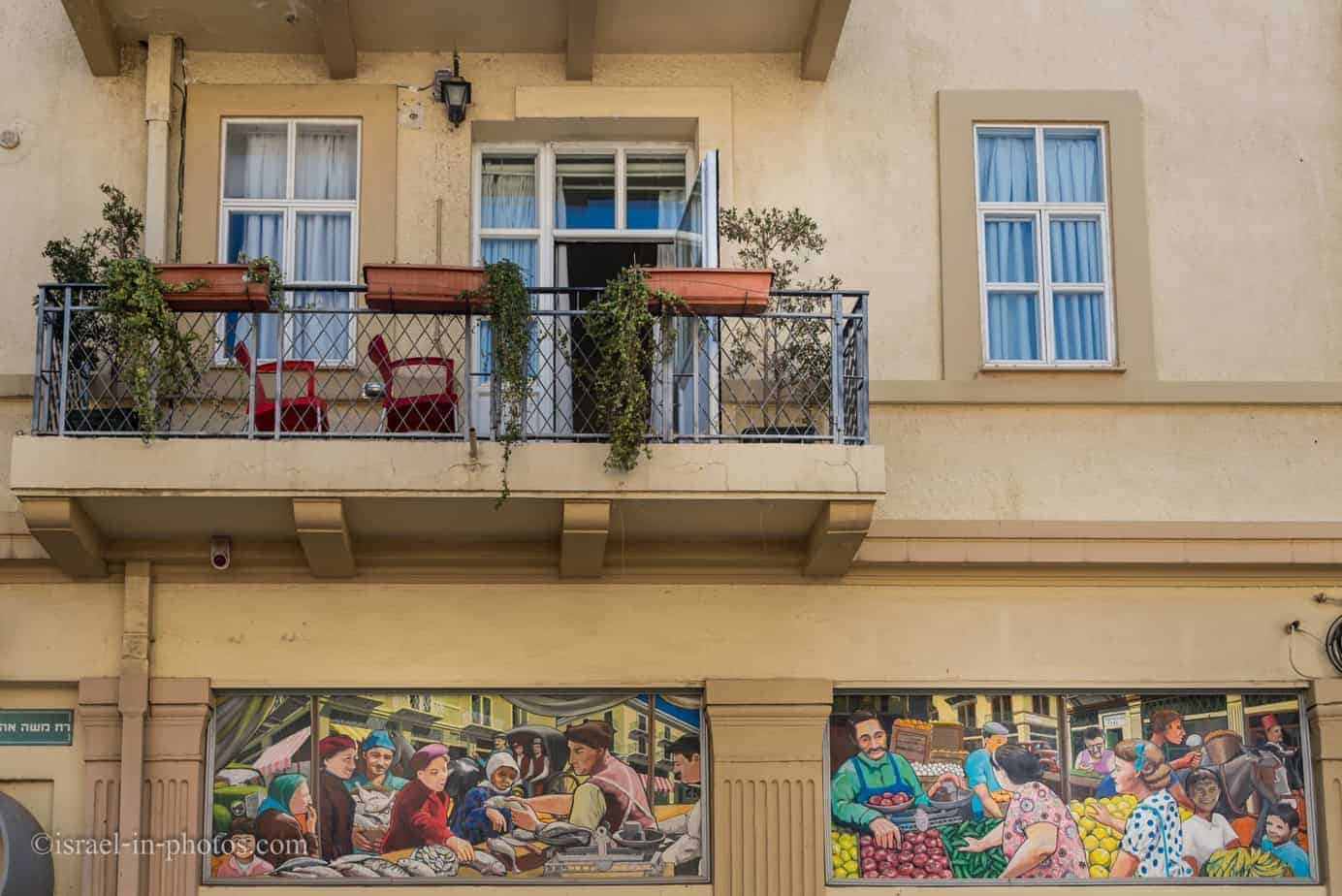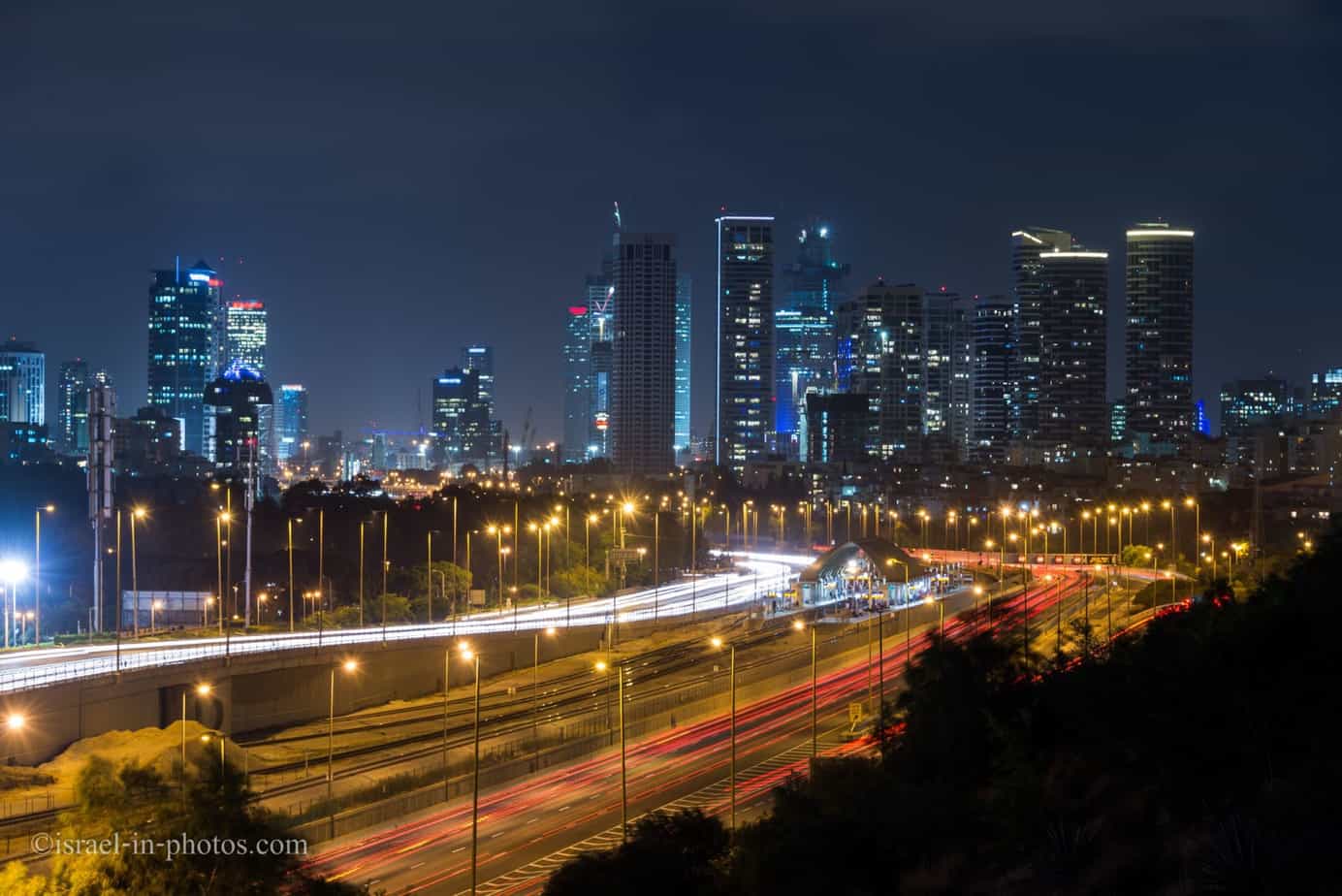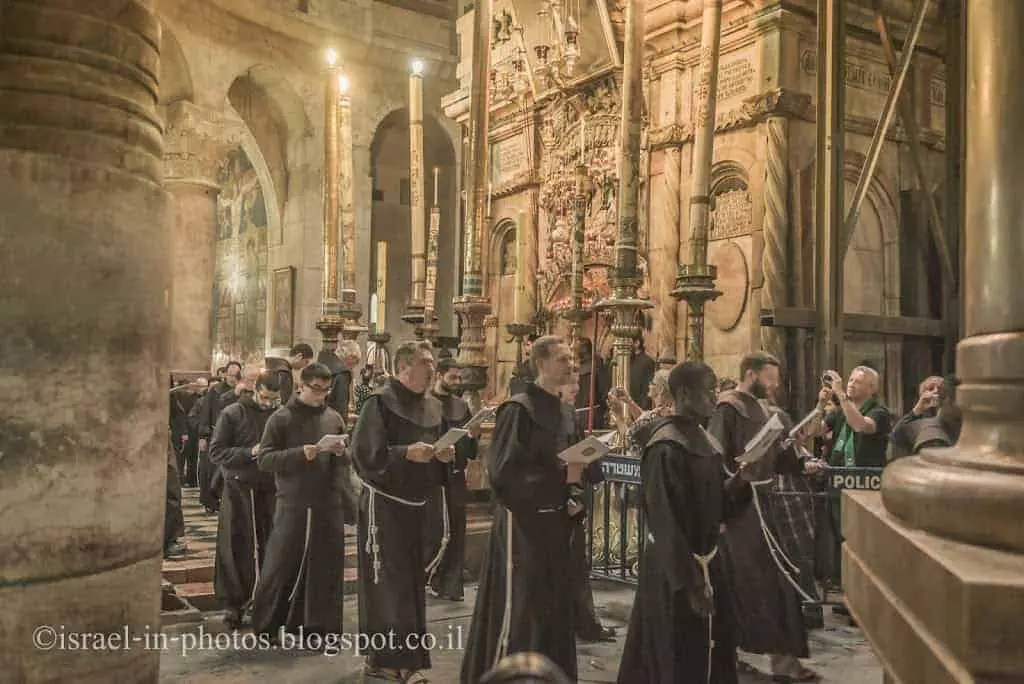Three Days in Athens – Visitors Guide
We will visit Acropolis, Kerameikos, Lycabettus, Plaka, and many other touristic attractions during three full days in Athens. But first, let’s start with a map of the city.
Note: check the first part of our journey to central Greece.
Table of Contents
Athens Attractions Map
Here is a shot of touristic map we received in our hotel: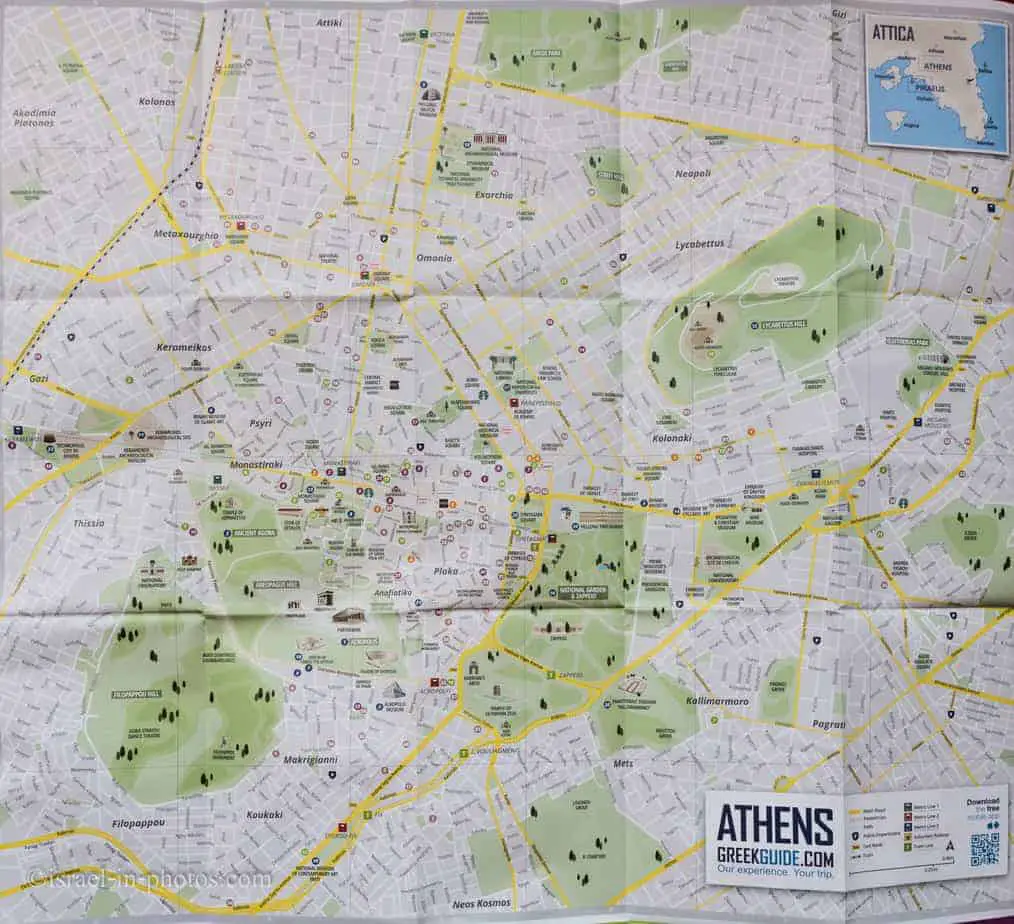
And here is the plan I prepared in Google Maps:
As you can see, the tourist attractions are pretty close to each other, and we did not use any transportation within the city. In other words, we walked.
Note: I covered all Greece basics in my Greece post.
Day 1 – Syntagma Square and Mount Lycabettus
On the morning of the first day, we returned the rental car to Athens. Before renting, I checked the price difference between renting at the airport and returning to the airport versus returning to Athens. Returning to another location was a little more expensive, but if I took three public transport tickets from the airport to Athens city center, it became cheaper to return the car in the city. Moreover, the rental car agency was about 1 km from our hotel, making it convenient as we walked this distance.
When we returned the car and checked into the hotel, it was almost noon. The Acropolis of Athens is probably the most popular tourist attraction, and it is visited by thousands (if not tens of thousands) of people daily. Thus, if you want to visit Acropolis, it is advised to come early or late in the afternoon. Therefore, we left Acropolis for the second day of the trip. And on the first day, we decided to get familiar with the city. And there is no better way to learn about a city than on foot. Visiting a viewpoint is also an excellent way to get familiar with a city. So we did both of those things on the first day.
Monastiraki
Our hotel was within several minutes walk from Monastiraki square. We chose this location since it is close to most tourist attractions. Moreover, there is a metro station at Monastiraki square. You can use the metro to get to other parts of the city or the airport.
Thus, many of our city walks, like this one, started with a visit to Monastiraki square.
Here is Monastiraki with the Acropolis in the background.
As I noted previously, on one of the corners of Monastiraki square, there is a small church called Ekklesia Kimisi Theotokou Mitropoleos. Though there are no signs inside, photography is not allowed there.
We decided to visit one of the best viewpoints in Athens, Mount Lycabettus. And we walked there via Syntagma Square.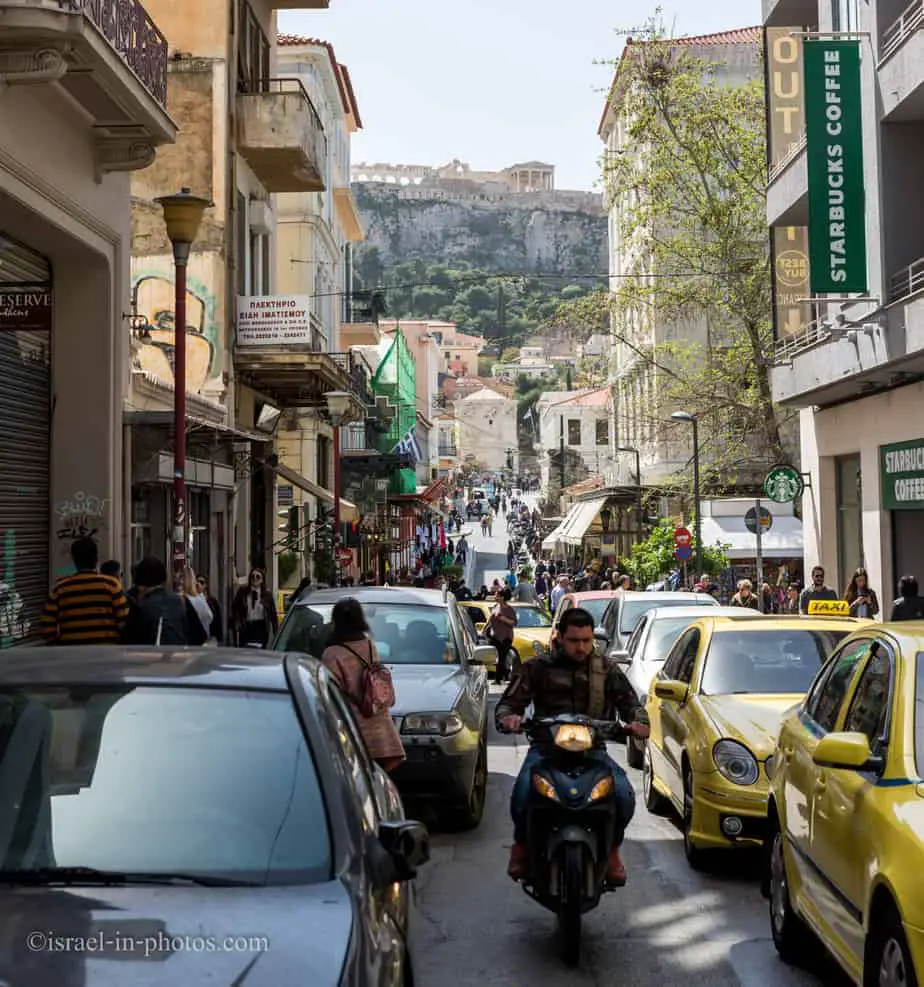
Church of Panagia Kapnikarea
On our way, we passed next to the Church of Panagia Kapnikarea. This Greek Orthodox church, also known as Kapnikarea, is one of the oldest churches (built around the 11th century) in Athens.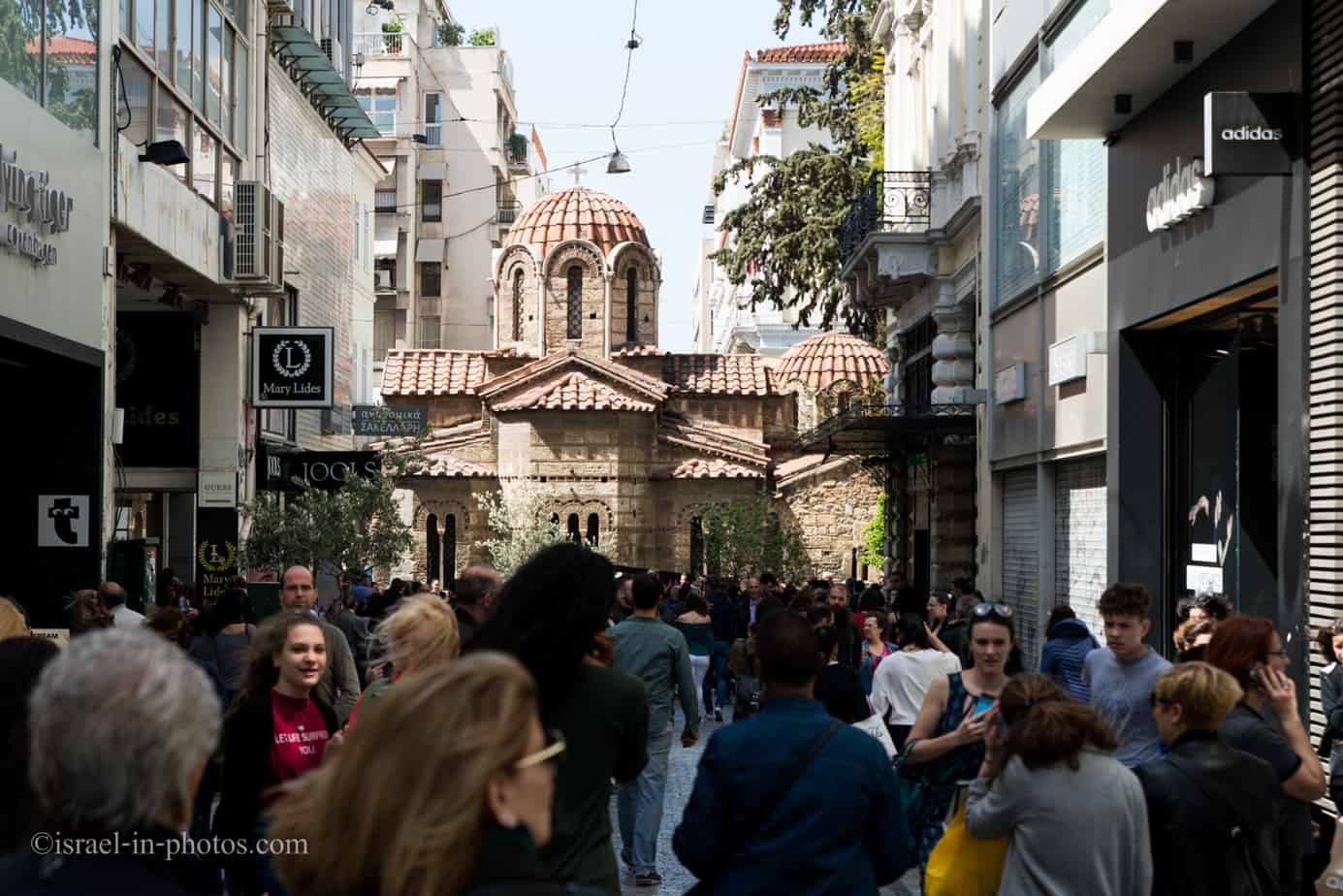
It is located in the middle of Ermou street, a high-traffic shopping area, at the edge of the Plaka district.
As you can see, there are many people. After several days in small villages, with few people around, it took us some time to get used to the crowds.
Syntagma Square
Syntagma Square is the central square of Athens. The square is named after the Constitution that Otto, the first King of Greece, was obliged to grant after a popular and military uprising on 3 September 1843. It is located in front of the 19th century Old Royal Palace, housing the Greek Parliament since 1934. Syntagma Square is the most important square of modern Athens from both a historical and social point of view, at the heart of commercial activity and Greek politics.
Source: Wikipedia
View of Syntagma Square towards the Old Royal Palace: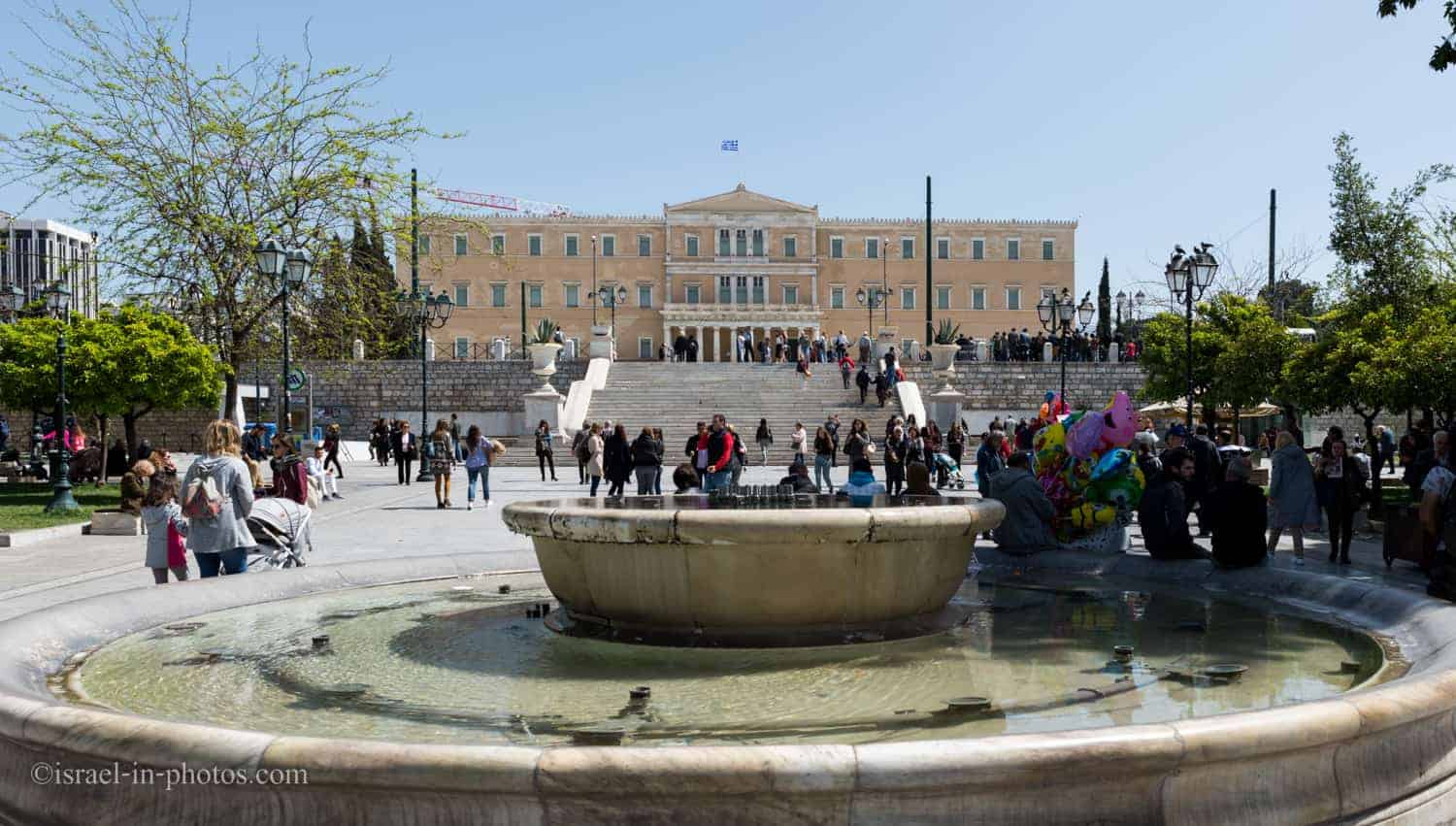
We crossed the road towards the Royal Palace, which houses the Greek parliament. You can find the Tomb of the Unknown Soldier, which Greek army soldiers guard. The soldiers are dressed in festive uniform and changing of the guard became a touristic attraction.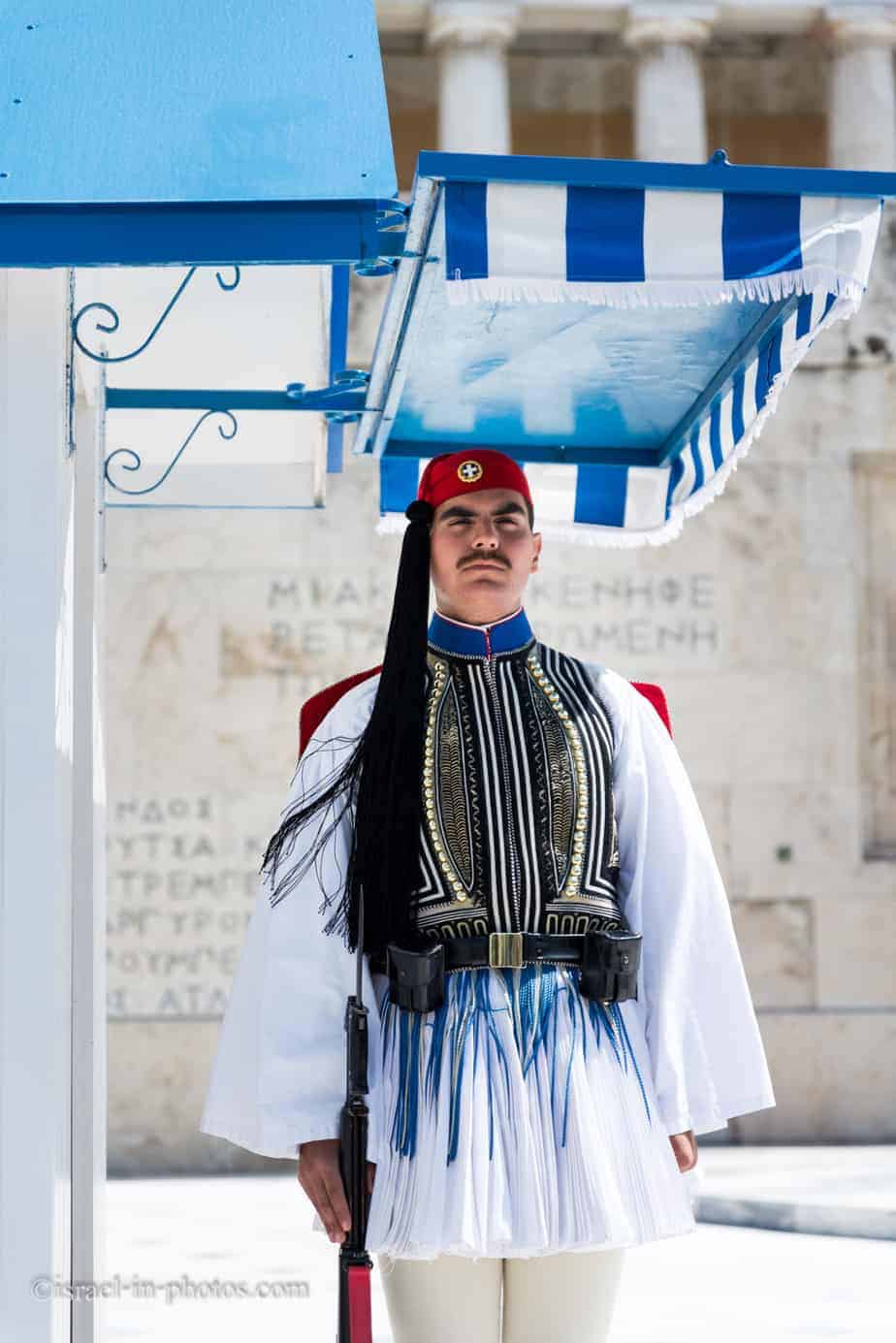
We did not witness the changing of the guard, but we saw their walk, which is unique as well. And after a fifteen minutes stop, we continued towards Mount Lycabettus.
Mount Lycabettus
Though I read about railway funicular to Mount Lycabettus, I was unsure what altitude is started. The funicular saves you only the last part of the hill (about fifty meters). And most of the climb is done by foot using stairs like in the following photo.
On a hot day like the one we had, the climb was sweaty.
We used Ploutarchou street to climb the mountain, and the funicular is located at the end of that street on the junction Ploutarhou and Aristippou streets.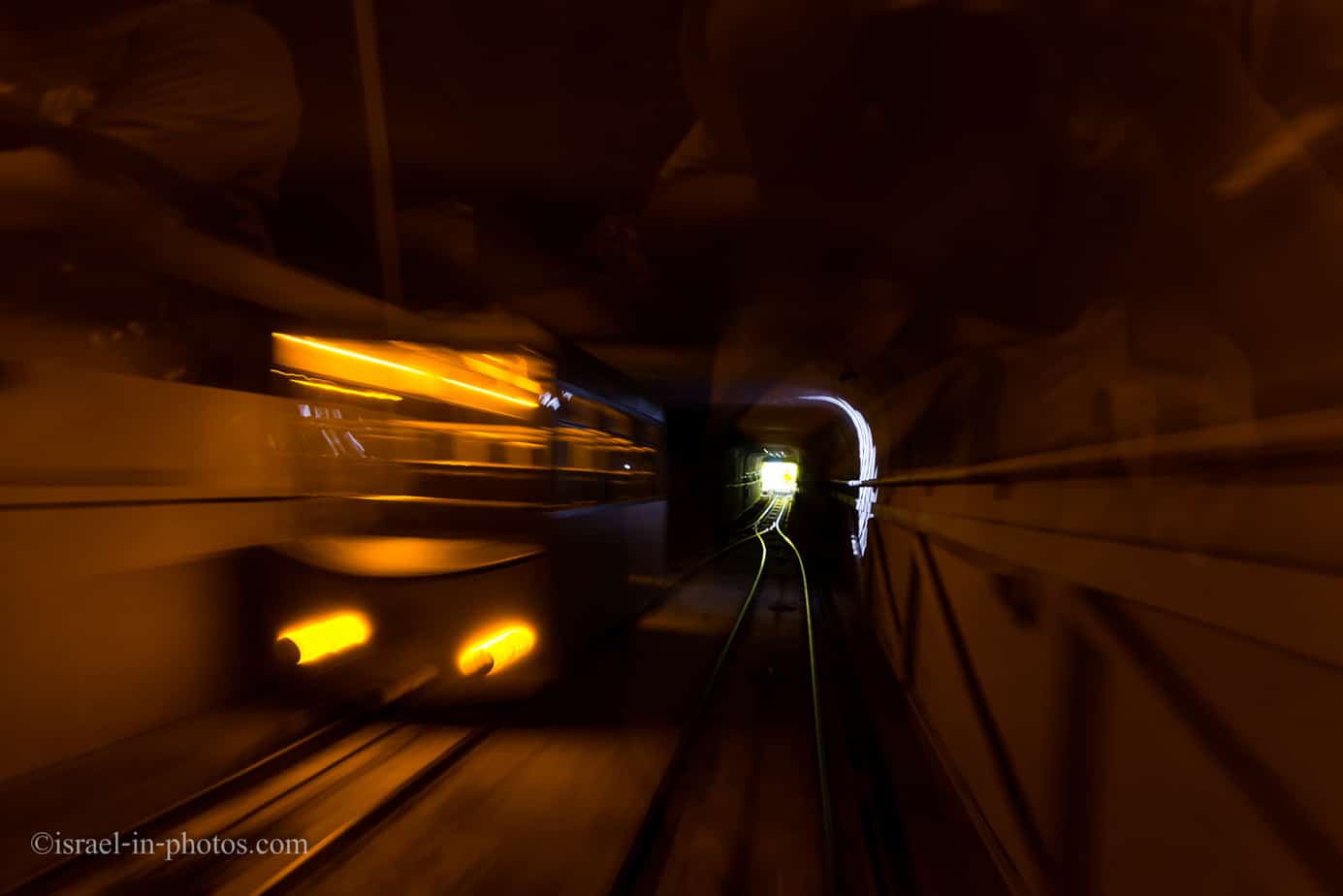
As you can see from the photo above, the funicular is in a tunnel. Thus there is no view. Moreover, it was pretty expensive (as far as I remember, 7.5 Euro per person) for a two-minute ride. Therefore, if I were alone, I would skip it. But since we traveled with our daughter, and a funicular ride for kids is an attraction by itself, we decided to use it.
On the top of Mount Lycabettus, there is a restaurant, Church of St. George (shown in the next photo) and a small viewing platform.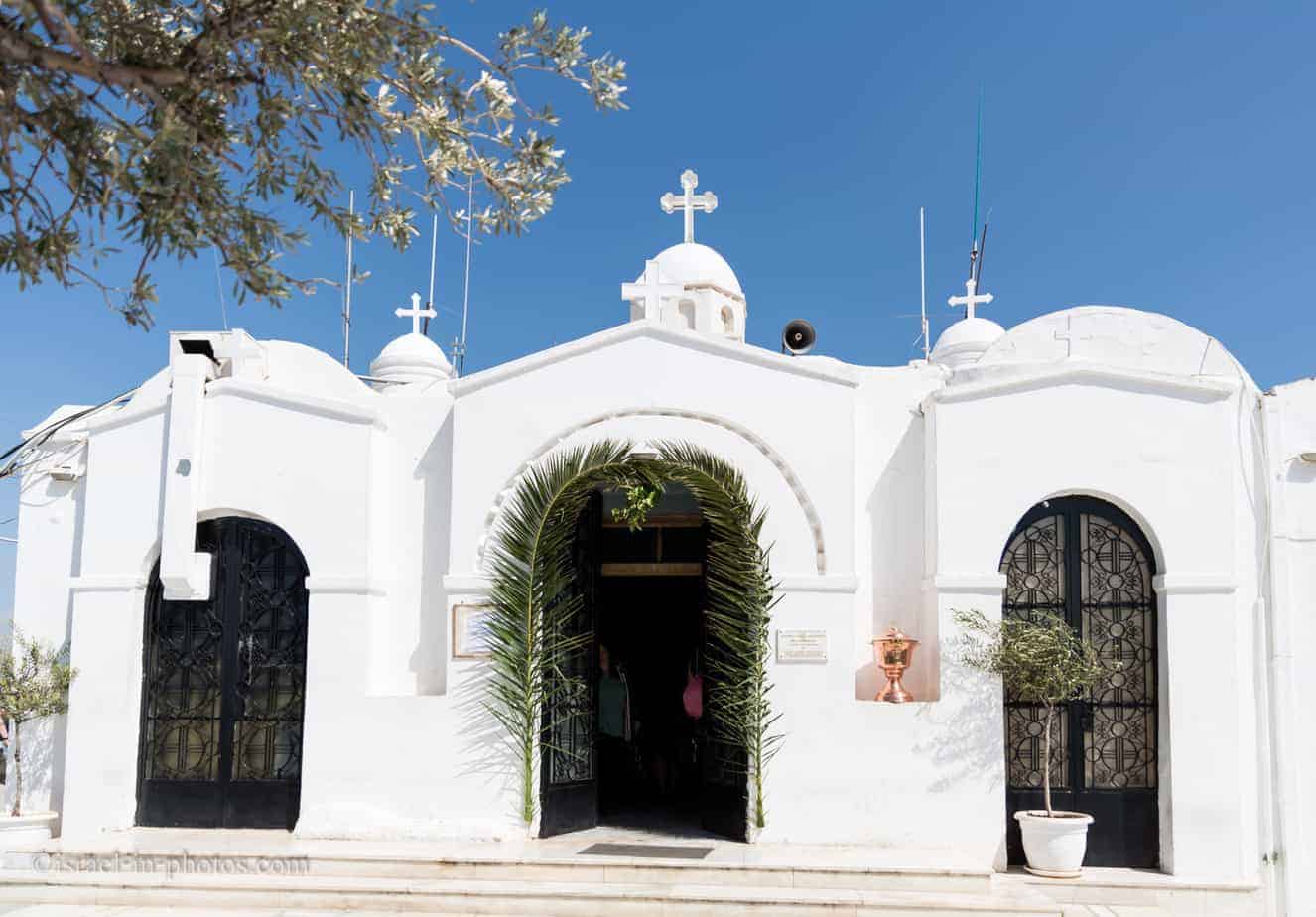
The views from Lycabettus are stunning.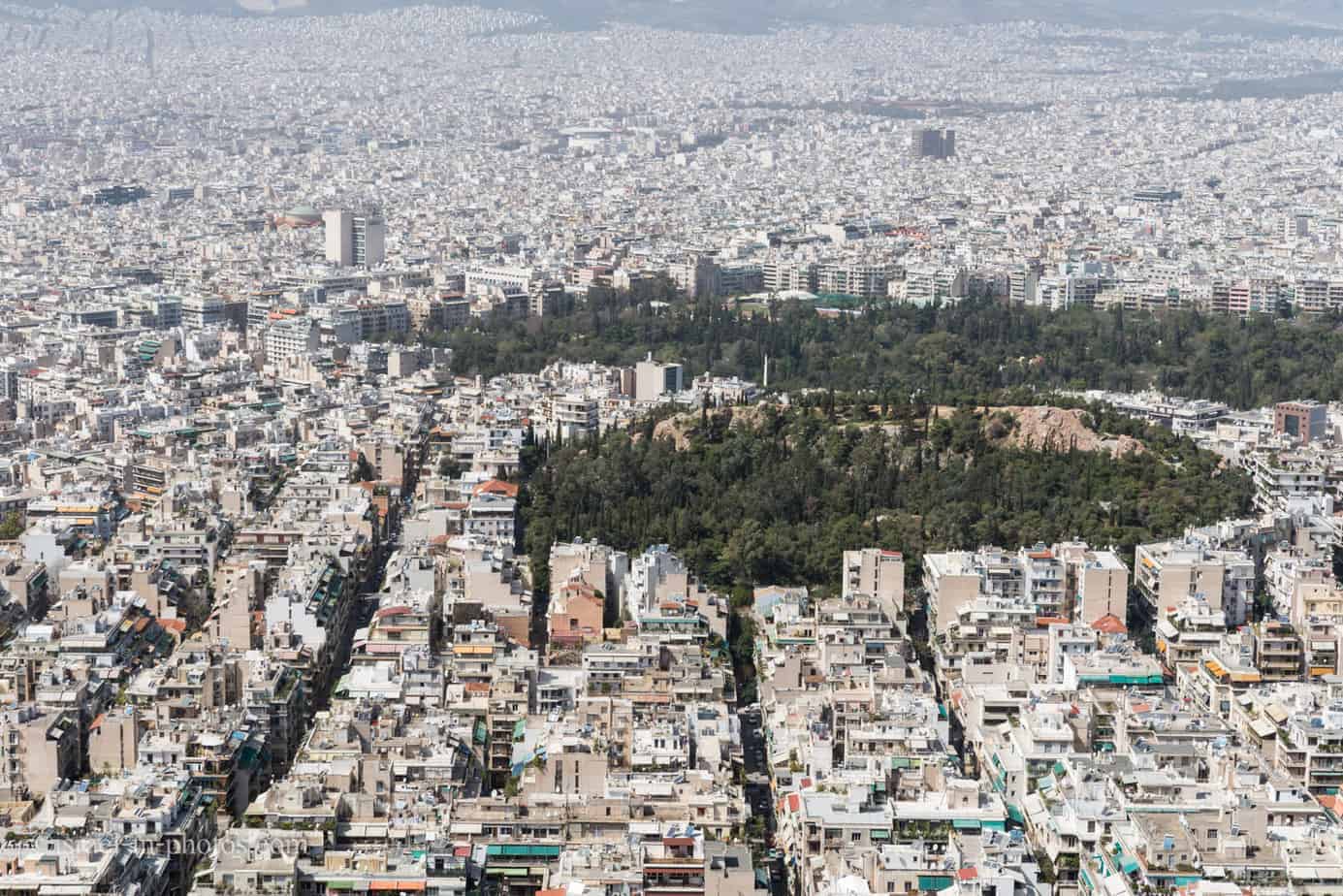
Looking towards the Acropolis of Athens:
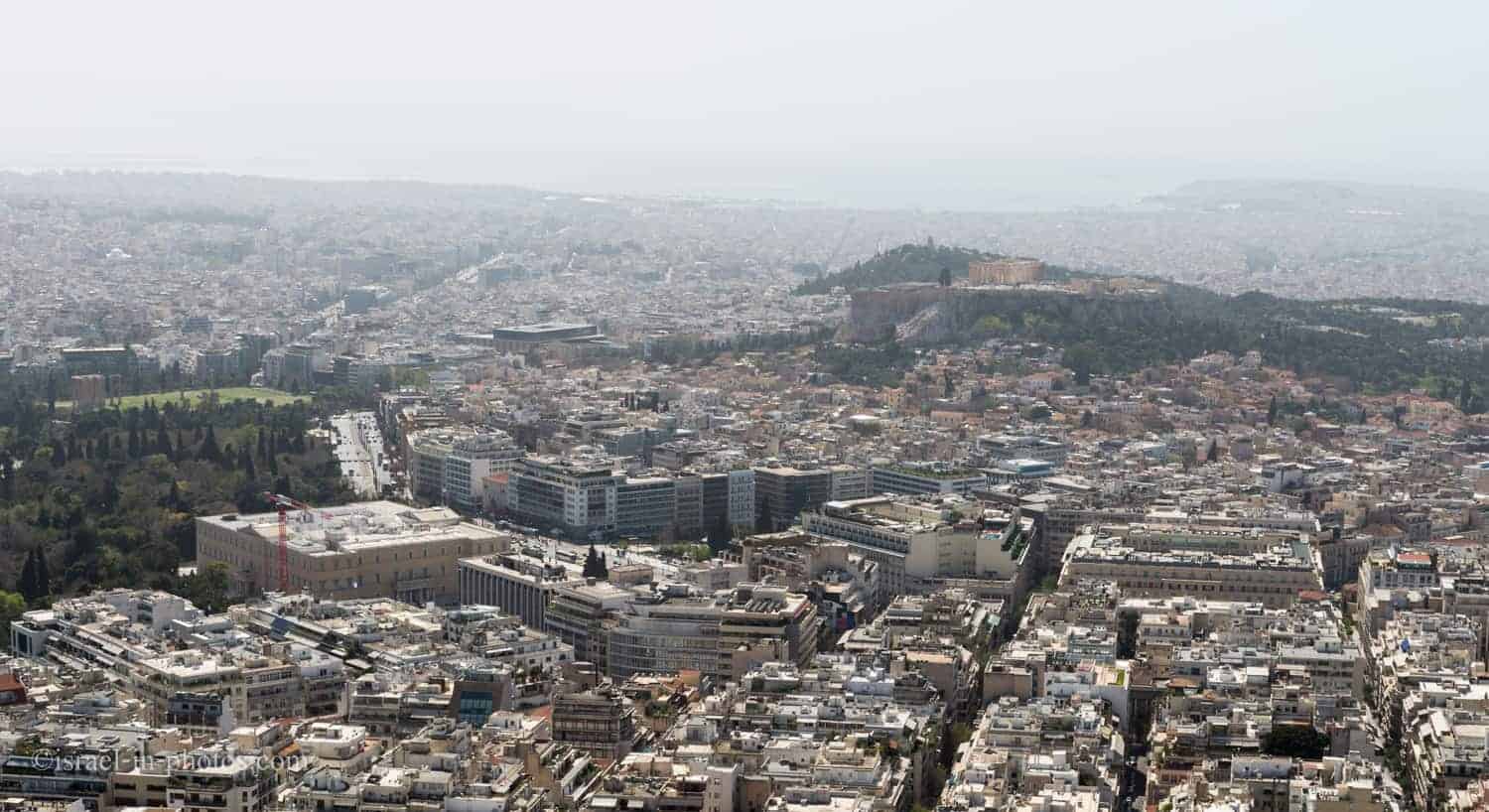 In the photo above, the big square building on the left (with the red crane nearby) is the Greek parliament we visited earlier.
In the photo above, the big square building on the left (with the red crane nearby) is the Greek parliament we visited earlier.
A closeup of the Acropolis of Athens:
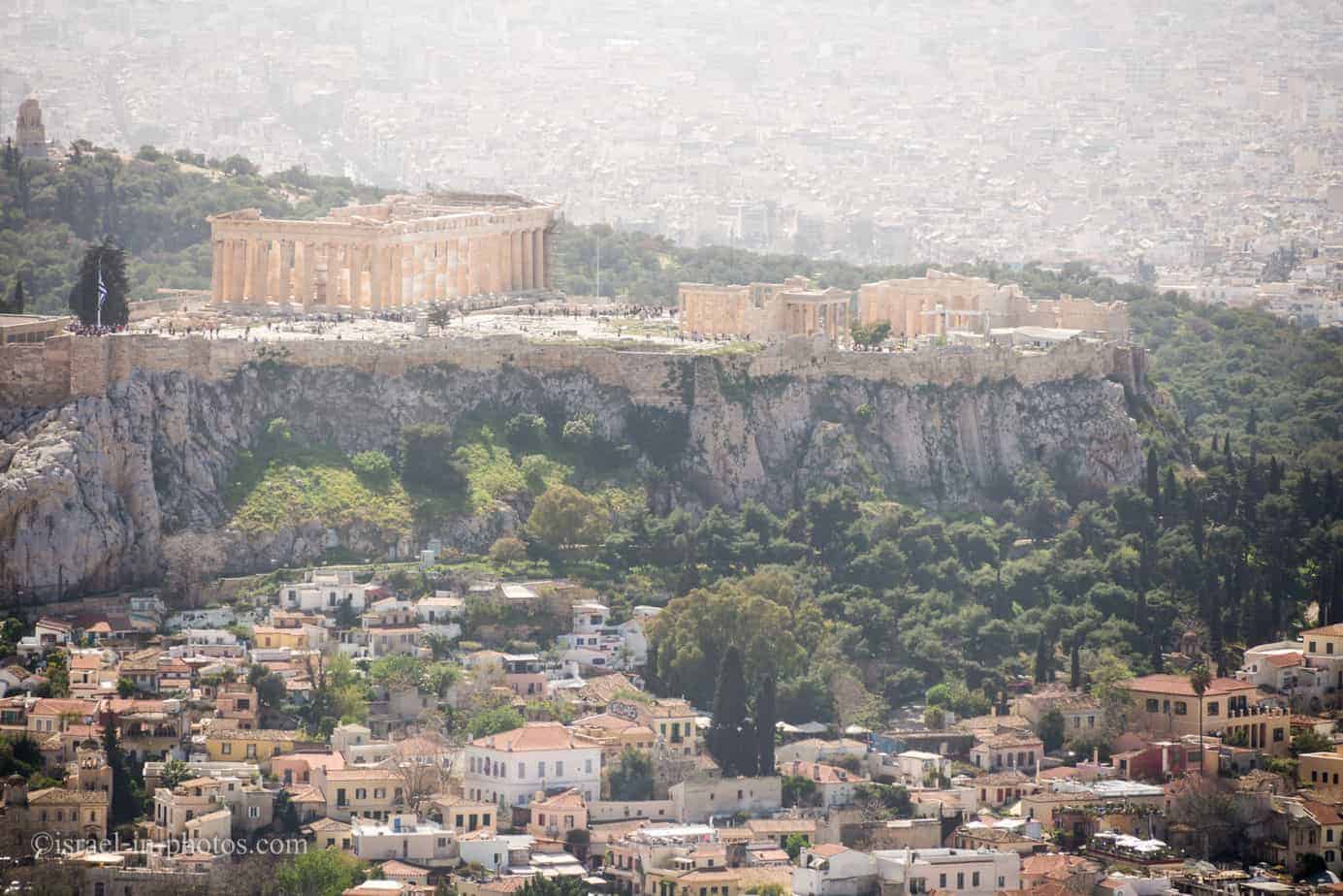
The Acropolis is not close, and how good you can see it depends on the weather. To give a reference to photographers, the photo above was made using a 300 mm focal length on a full-frame body.
Restaurants
From Mount Lycabettus, we returned to Monastiraki and searched for a place for dinner. There are many good restaurants in this area. But there are many touristic spots as well. Thus, I would suggest using recommendations and reviews. We used the Google maps app to find the best places around us.
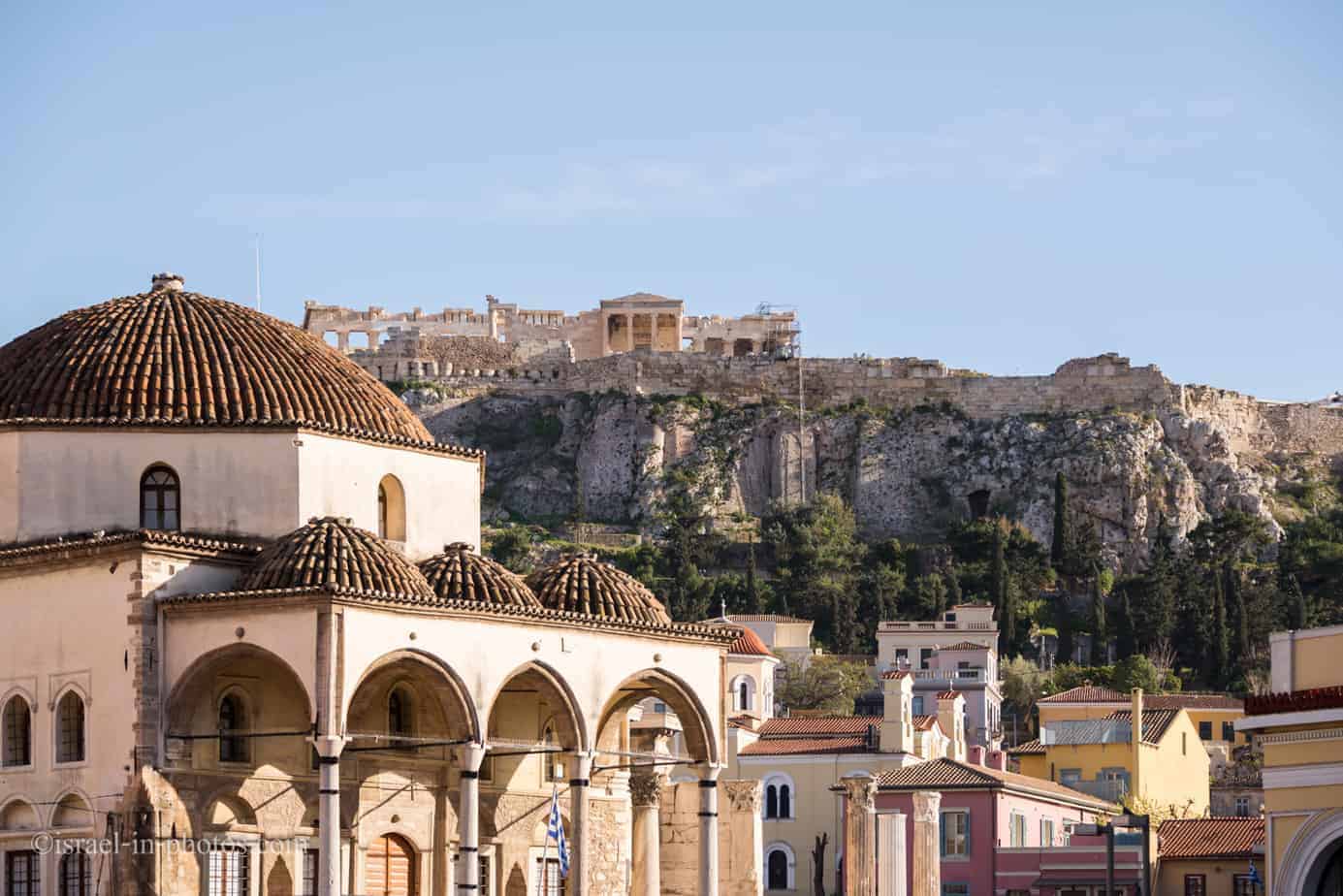
I mentioned costs in my previous post about Greece. Here I will say that prices are similar to other European countries and Athens is more expensive than smaller cities and villages in Greece. The main dish will typically cost 8 – 14 Euro, 4 – 8 Euro for a starter, and several Euros per soft drink. Thus, a typical dinner for us (two adults and one child), consisting of several starters, three main dishes, drinks and sometimes a dessert, would end up costing around 50 Euro.
While walking after dinner, I saw this heart-shaped lamp leading to a restaurant. A simple yet effective way to make people notice you.

Day 2 – Acropolis of Athens and National Archaeological Museum
On the morning of the second day, we headed to the Acropolis. We noticed that many side streets in Athens were covered with graffiti during our visit.
Graffiti
Travelers to Athens cannot help but notice the amount of graffiti in the city. Any surface that can be sprayed upon is covered with a disturbing number of signatures and designs. Beautifully restored neo-classic houses from the late 19th century usually have a few days or weeks before they are covered in graffiti, and owners find themselves in a war that they eventually lose and surrender to the kids.
Source: athensguide.com
Acropolis Of Athens
During our trip, the Acropolis was the most expensive attraction in Greece. The ticket price was 20 Euro per person.
After purchasing entrance tickets, the first site we saw was the Odeon of Herodes Atticus. But first, let’s start with quick background info.
Background Info
The Acropolis of Athens is an ancient citadel located on a rocky outcrop above the city of Athens. It contains the remains of several ancient buildings of great architectural and historical significance, the most famous being the Parthenon. The word Acropolis is from the Greek words ἄκρον (Akron, “highest point, extremity”) and πόλις (polis, “city”). Although the term acropolis is generic, and there are many other acropoleis in Greece, the significance of the Acropolis of Athens is such that it is commonly known as “The Acropolis” without qualification. During ancient times it was also known more properly as Cecropia, after the legendary serpent-man, Cecrops, the first Athenian king.
While there is evidence that the hill was inhabited as far back as the fourth millennium BC, it was Pericles (c. 495 – 429 BC) in the fifth century BC who coordinated the construction of the site’s most important present remains, including the Parthenon, the Propylaia, the Erechtheion and the Temple of Athena Nike. The Parthenon and the other buildings were damaged seriously during the 1687 siege by the Venetians during the Morean War when gunpowder being stored in the Parthenon was hit by a cannonball and exploded.
Source: Wikipedia
Odeon of Herodes Atticus
Odeon of Herodes Atticus got its name after Herodes Atticus, who donated this Odeon to the city of Athens. It was used for musical events and philosophical lectures. And this theater is still used. Frank Sinatra, Luciano Pavarotti, Yanni, Sting, and Elton John are just some of the performers that had their concerts here.
The Odeon has 39 rows of marble seats that host up to 6,000 spectators.
This photo at the Propylaea (monumental gateway) was taken at 10 am, and there were already many people. Also, note that we traveled not during the high season, and during summer, there are probably even more tourists.
Thus, either come early or later in the afternoon.
Parthenon
The Parthenon is a former temple on the Athenian Acropolis, Greece, dedicated to the goddess Athena, whom the people of Athens considered their patron. Construction began in 447 BC when the Athenian Empire was at the peak of its power. It was completed in 438 BC, although decoration of the building continued until 432 BC. It is the most important surviving building of Classical Greece, generally considered the zenith of the Doric order. Its decorative sculptures are considered some of the high points of Greek art.
The Parthenon is regarded as an enduring symbol of Ancient Greece, Athenian democracy, Western civilization, and one of the world’s greatest cultural monuments. To the Athenians who built it, the Parthenon and other Periclean monuments of the Acropolis were seen fundamentally as a celebration of Hellenic victory over the Persian invaders and as a thanksgiving to the gods for that victory. The Greek Ministry of Culture is currently carrying out a program of selective restoration and reconstruction to ensure the stability of the partially ruined structure.
Source: Wikipedia
As you can see, the restorations are still going on, and they will last till 2020.
Views from Acropolis
The Acropolis is located on a flat rock that rises 150 meters above sea level. That makes the Acropolis a historical site and an excellent viewpoint as well. Here are several views from the top.
The modern looking building in the far right of the next photo is the Acropolis Museum.
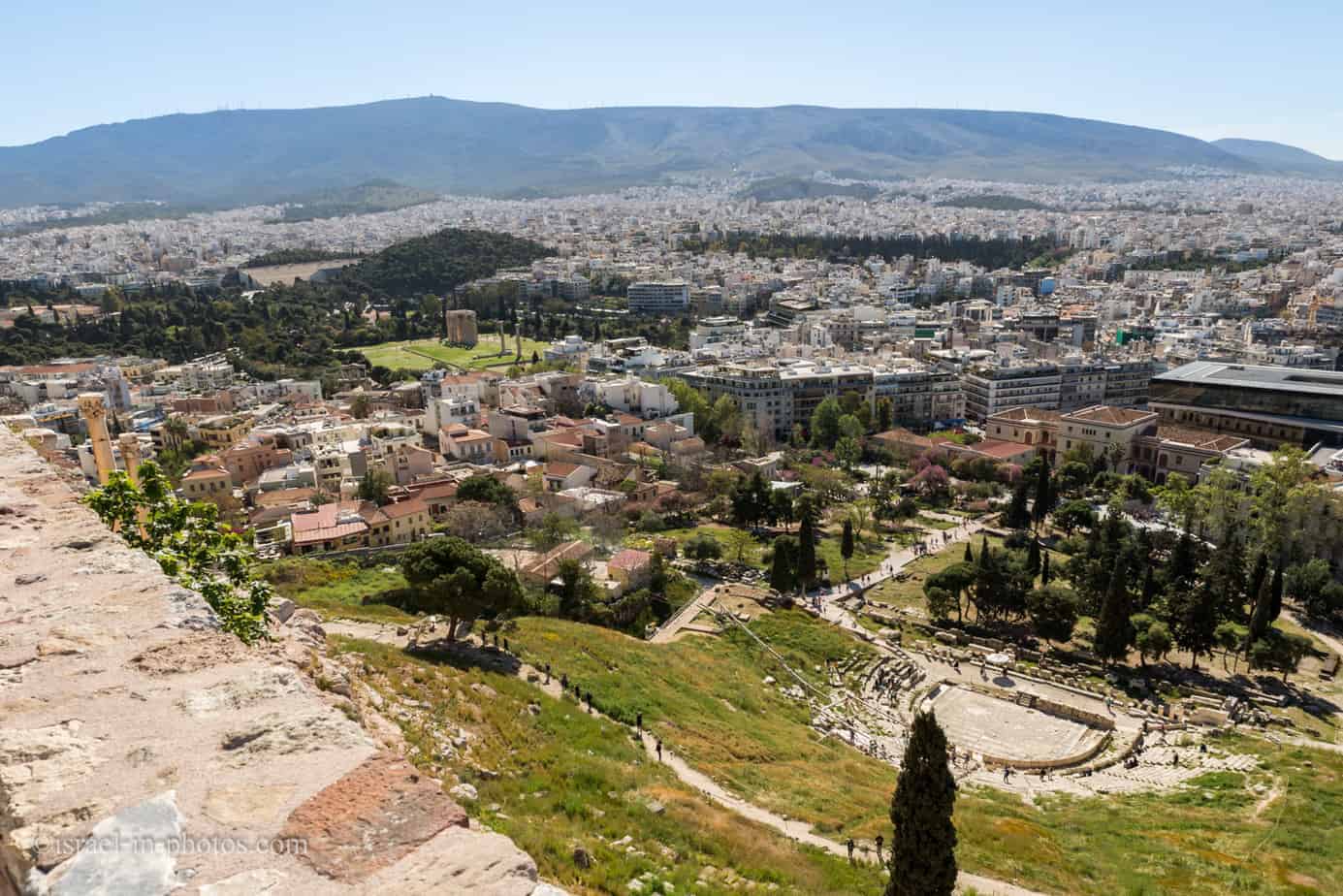
Parthenon from another side:

And here you can see Hadrian’s Arch with Temple of Olympian Zeus behind it.
Roofs of the Plaka neighborhood: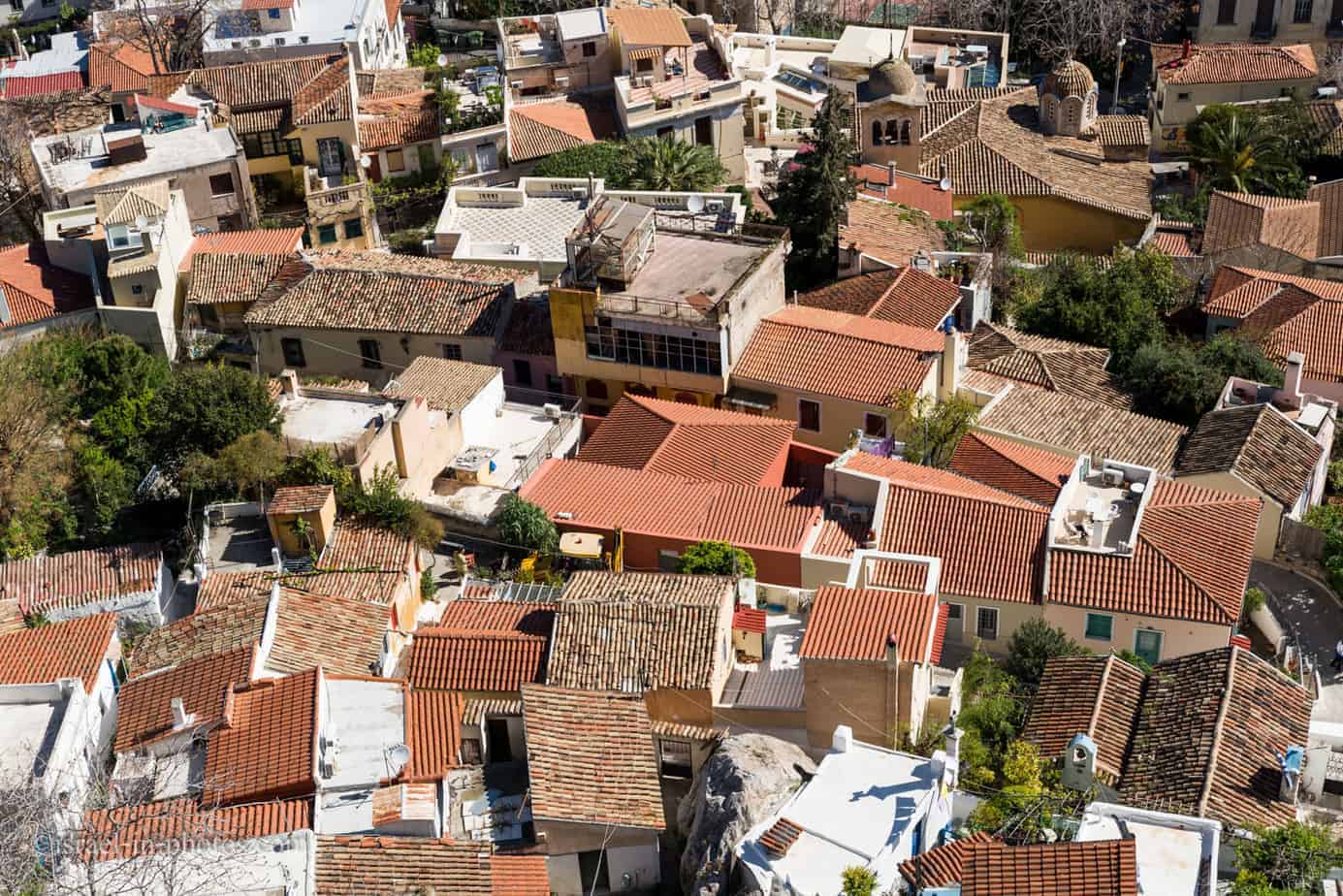
The mountain to the left is Mount Lycabettus, the viewpoint we visited the day before. And the two floor Royal Palace, the middle is the Greek Parliament.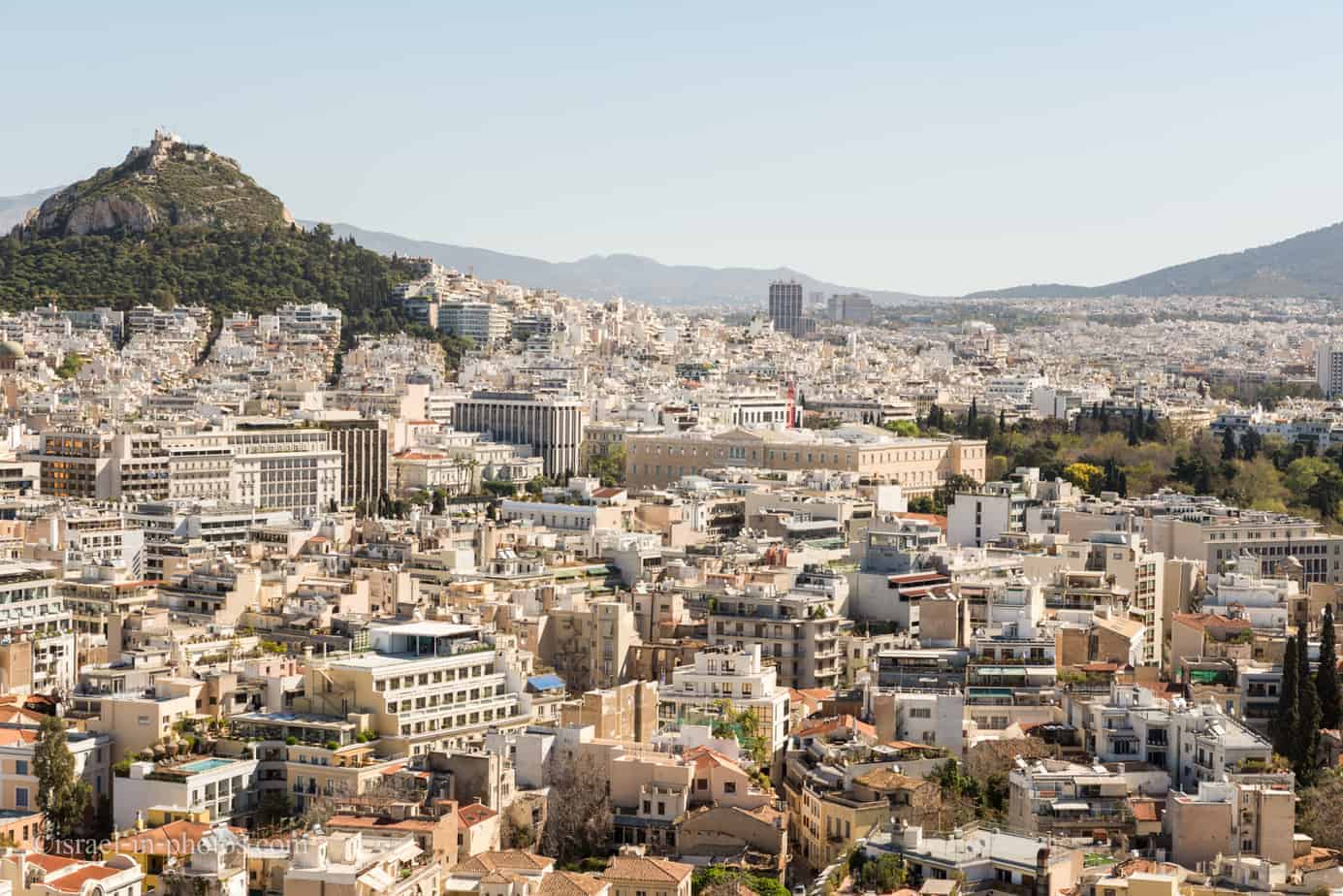
Erechtheion
The Ionic order building named Erechtheion after Erechtheus, the mythical king of Athens.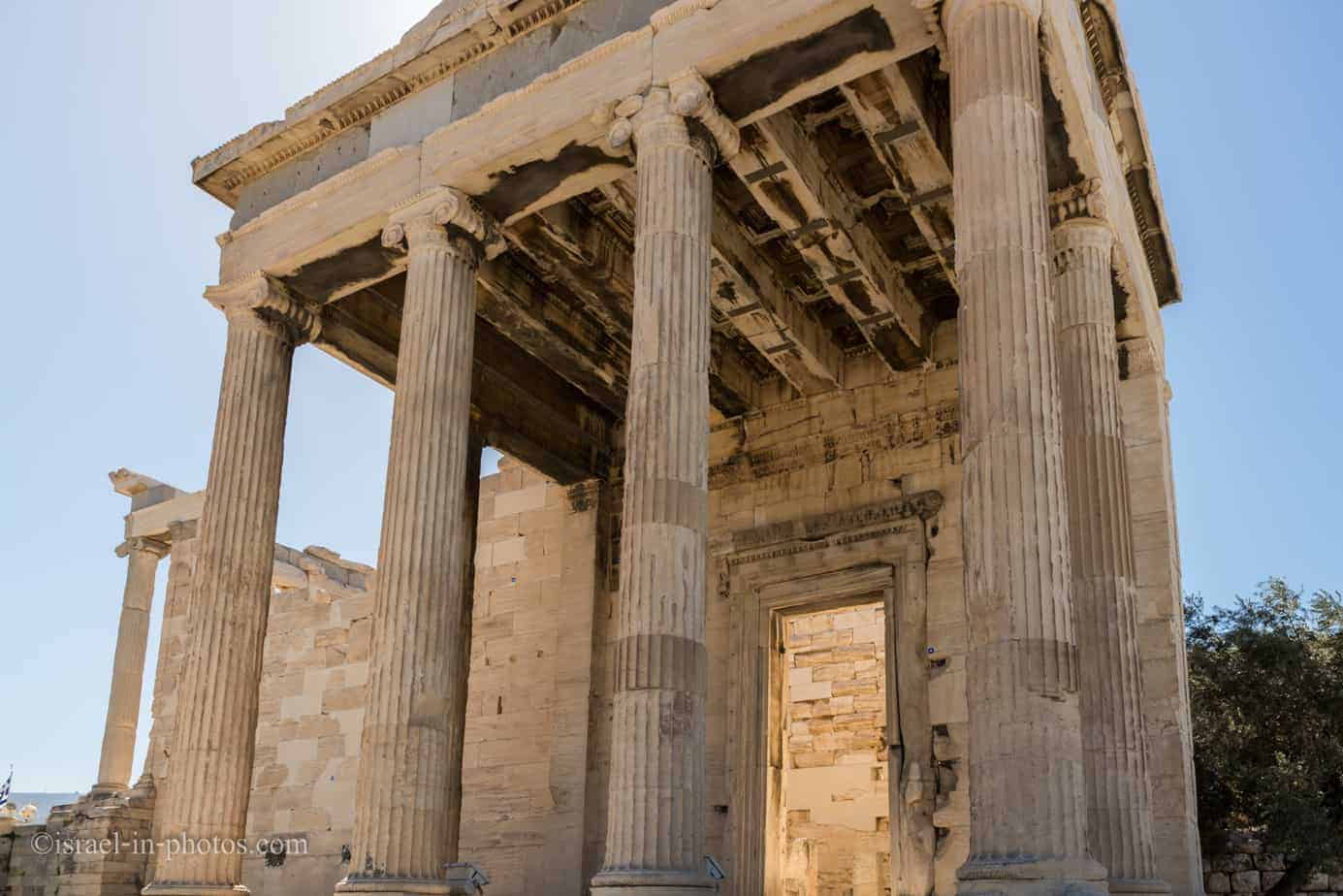
Erechtheion from another angle:
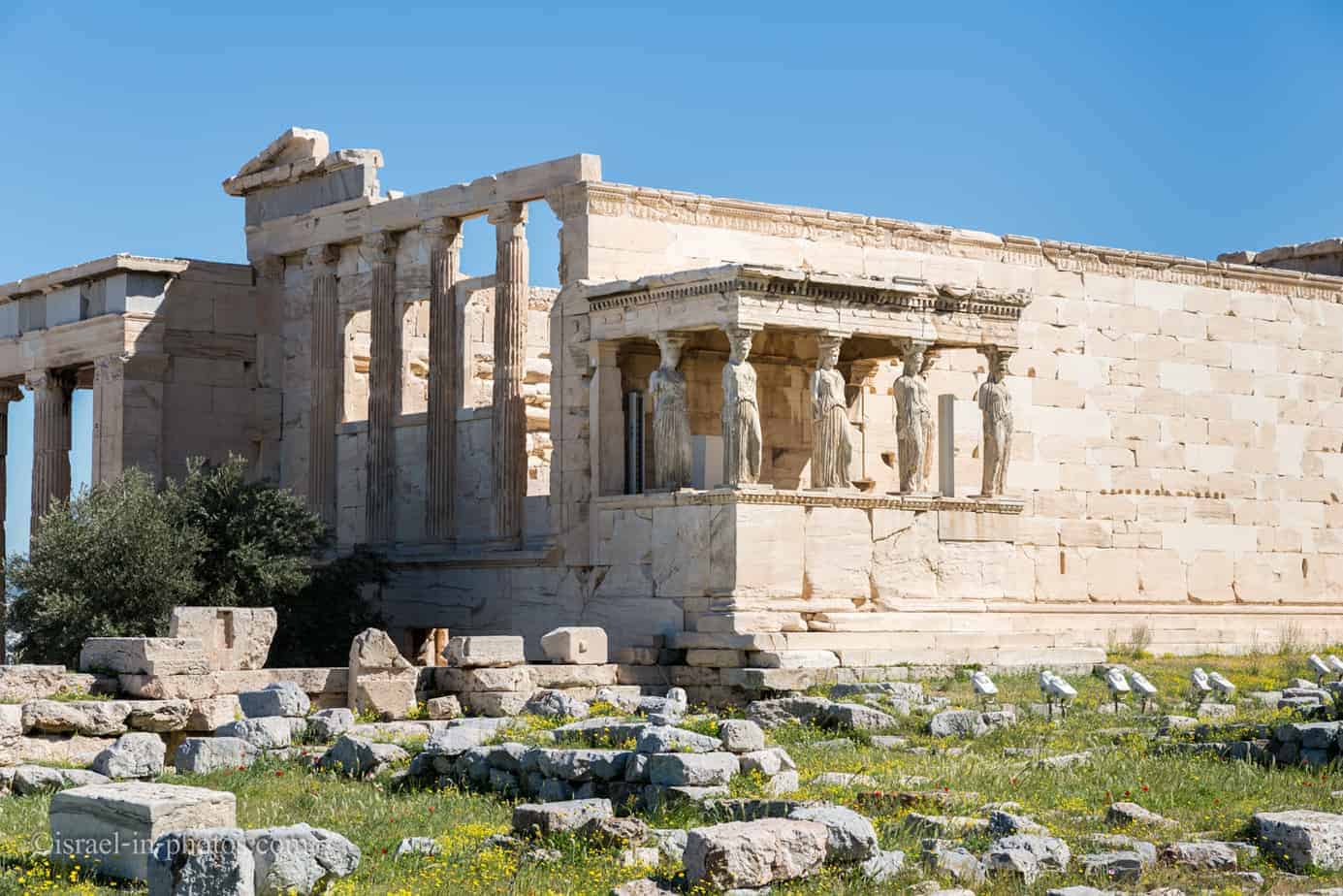
In the photo above, you can see the famous porch of the maidens. There are six statues of young women standing on a podium 1.77 meters high. The figures are replicas, and we will see the originals later on in the Acropolis museum.
I should also mention there are explanation signs next to each building in the Acropolis. They offer explanations both in Greek and English. And if you want to hire a private guide, you can do it, near the entrance to the site.
Temple of Athena Nike
We returned to the Propylaea (monumental gateway). One thing I have not shown before is the Temple of Athena Nike. It is located beside the portal.
The Temple of Athena Nike was dedicated to the goddess Athena Nike. Built around 420 BC, the temple is the earliest fully Ionic temple on the Acropolis. It has a prominent position on a steep bastion at the south-west corner of the Acropolis to the right of the entrance, the Propylaea. In contrast to the Acropolis proper, a walled sanctuary entered through the Propylaea, the Victory Sanctuary was open, entered from the Propylaea’s southwest wing, and form a narrow stair on the north. The sheer walls of its bastion were protected on the north, west, and south by the Nike Parapet, named for its frieze of Nikai celebrating victory and sacrificing to their patroness, Athena Nike.
Nike means “victory” in Greek, and Athena was worshipped in this form, representative of being victorious in war. The citizens worshipped the goddess in hopes of a successful outcome in the long Peloponnesian War fought against the Spartans and their allies.
Source: Wikipedia
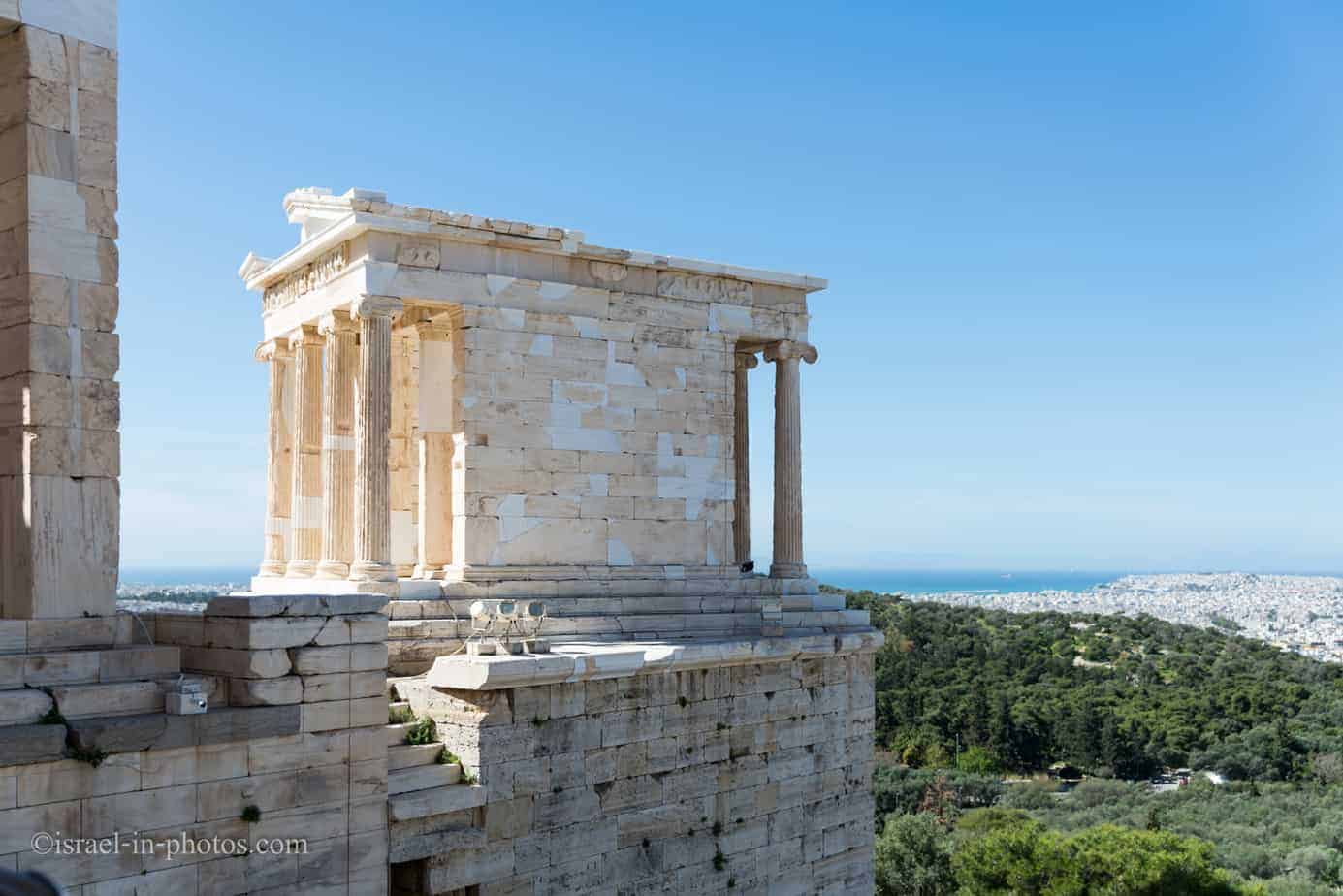
Our visit to Acropolis lasted about one and a half hours, and we continued to the Acropolis Museum.
Acropolis Museum
The Acropolis Museum is located on top of an ancient site. They elevated the museum, and you can see the place underneath. That is how the entrance to the museum looks.
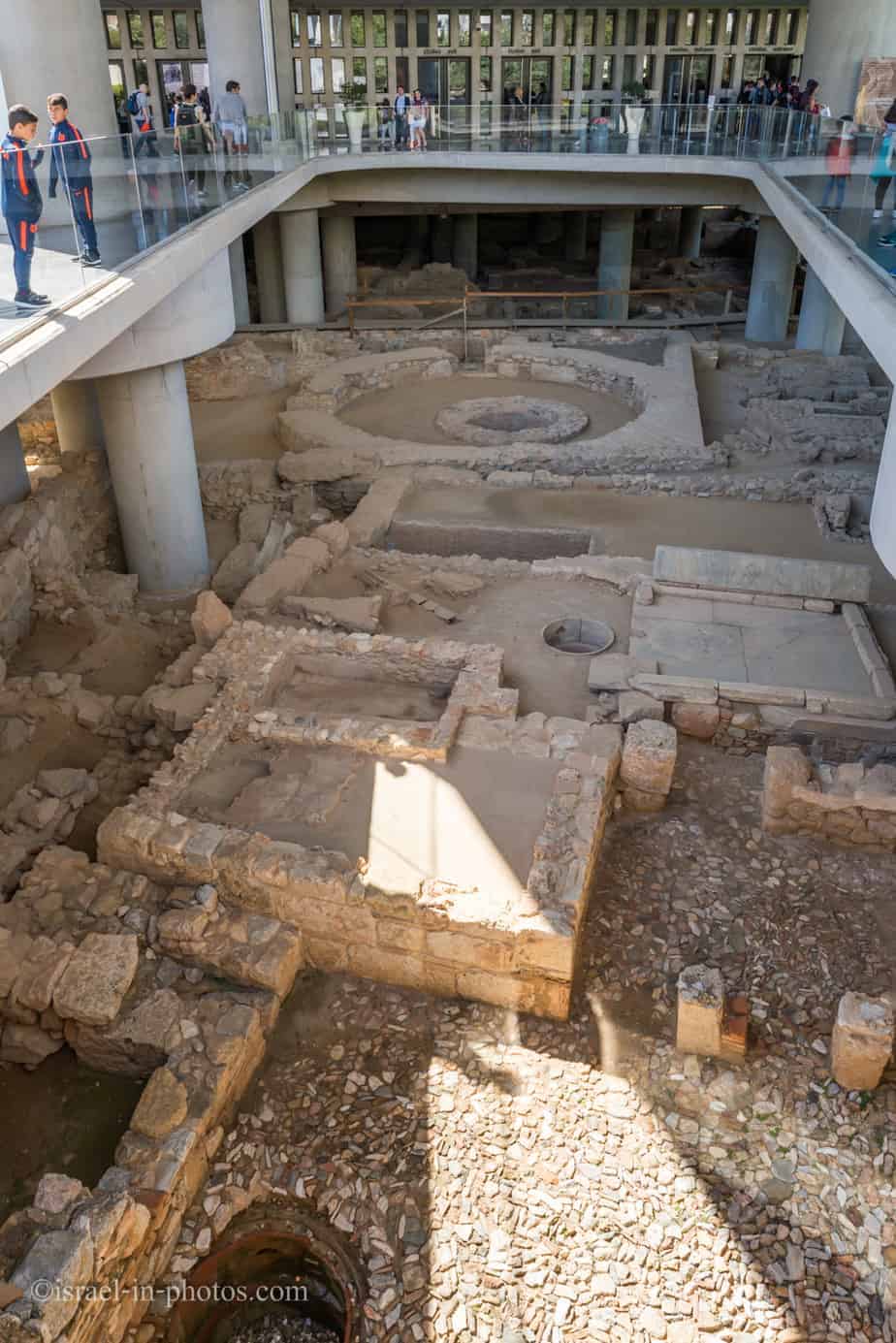
The Acropolis tickets do not include entrance to the Acropolis museum. Thus, if you want to visit the museum, you will need to buy the tickets for it. The entrance fee was 5 Euro per person.
The museum has two main floors. The lower floor mainly showcases small vessels and jewelry. Photography is not allowed there. And on the upper level, you can mostly find statues and bas-reliefs. Plus, photography is allowed there.
The statues from the Erechtheion: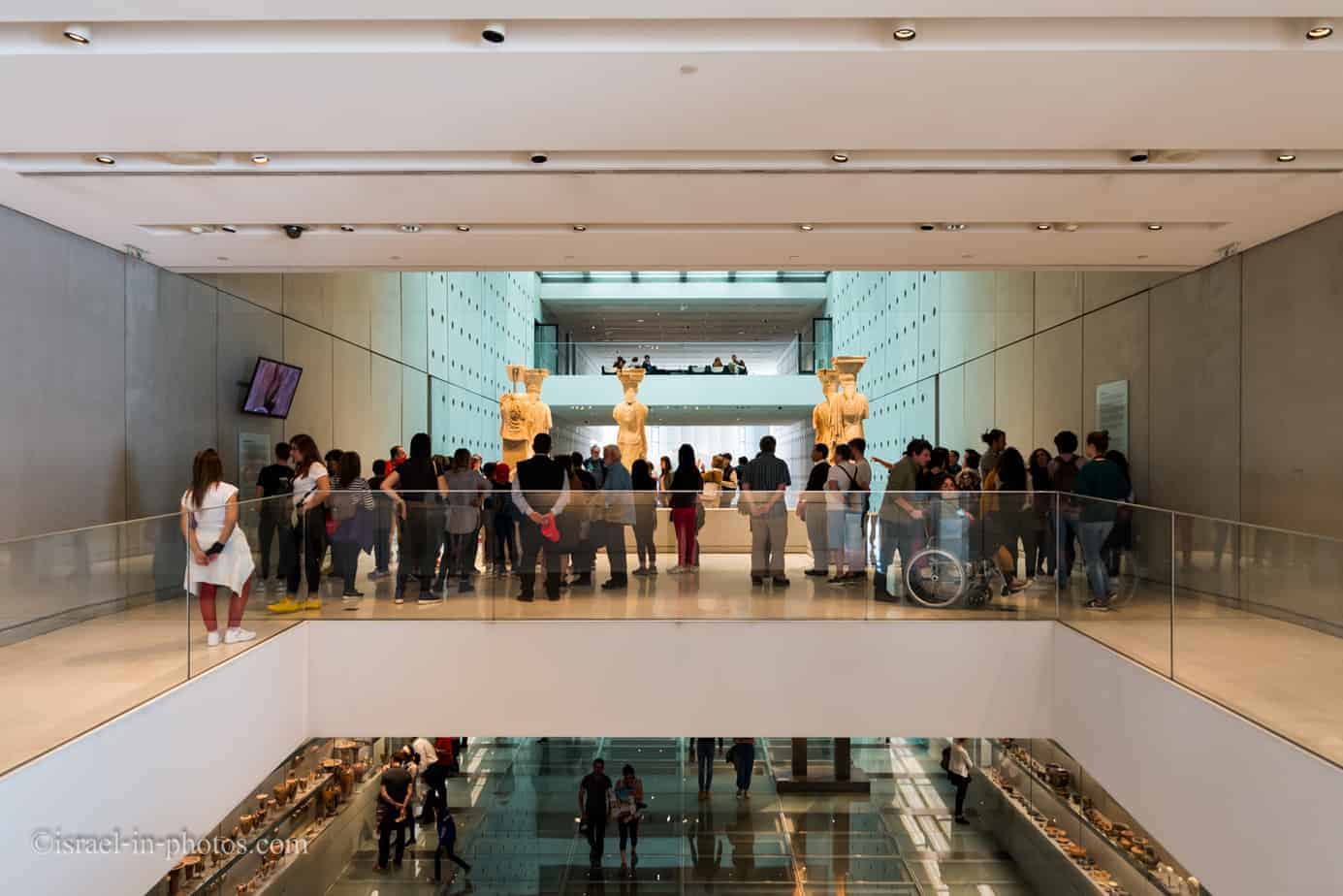
On the second floor: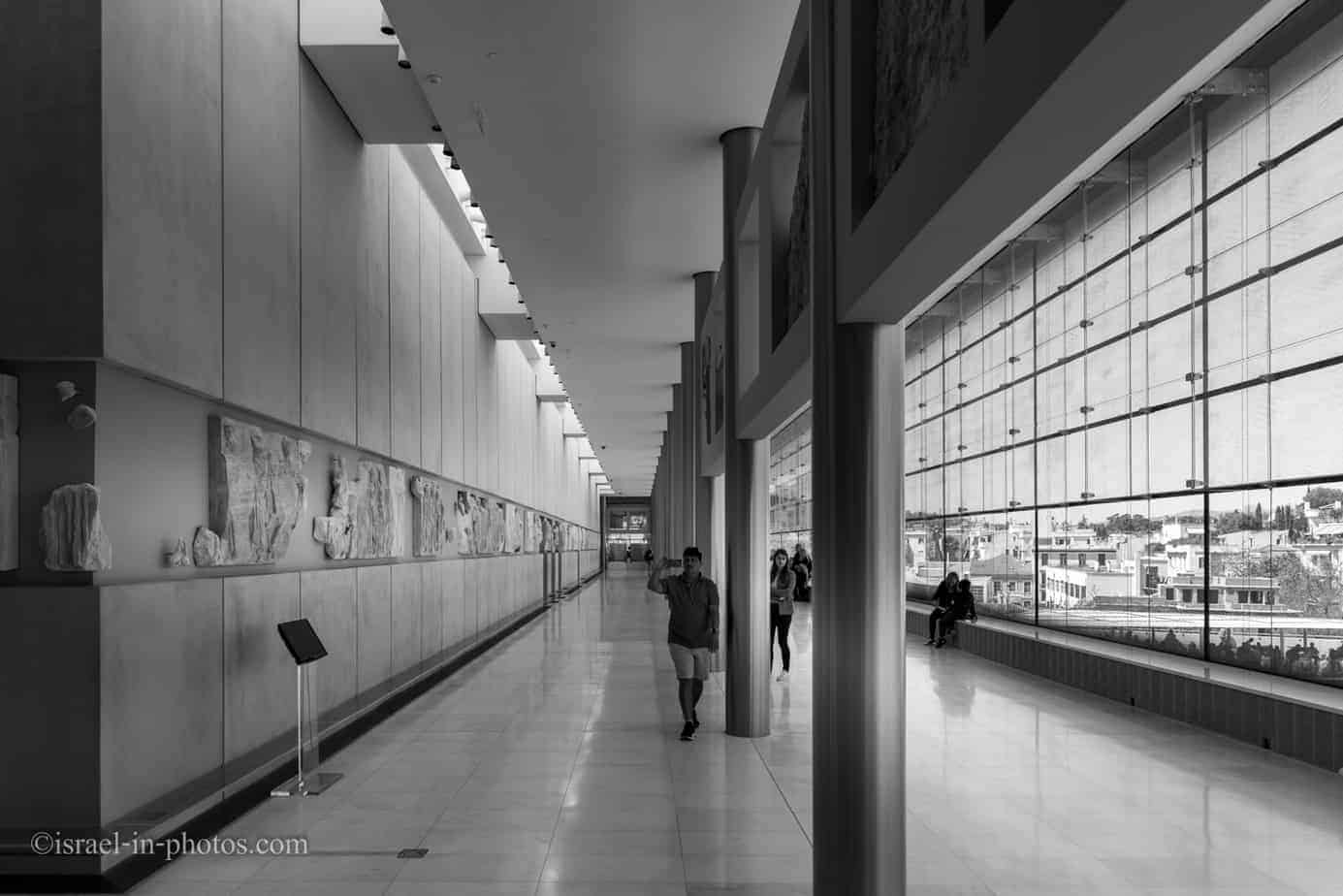
Acropolis Museum is not a big one, and in an hour and a half, we were able to cover it. Though not very thoughtfully since we traveled with our daughter, but I guess it is around the average amount of time that people spend there.
After the museum, we continued to the nearby Plaka neighborhood. It is the ideal place for shopping (mostly for souvenirs) and getting something to eat. And we were searching for the later.
Art gallery: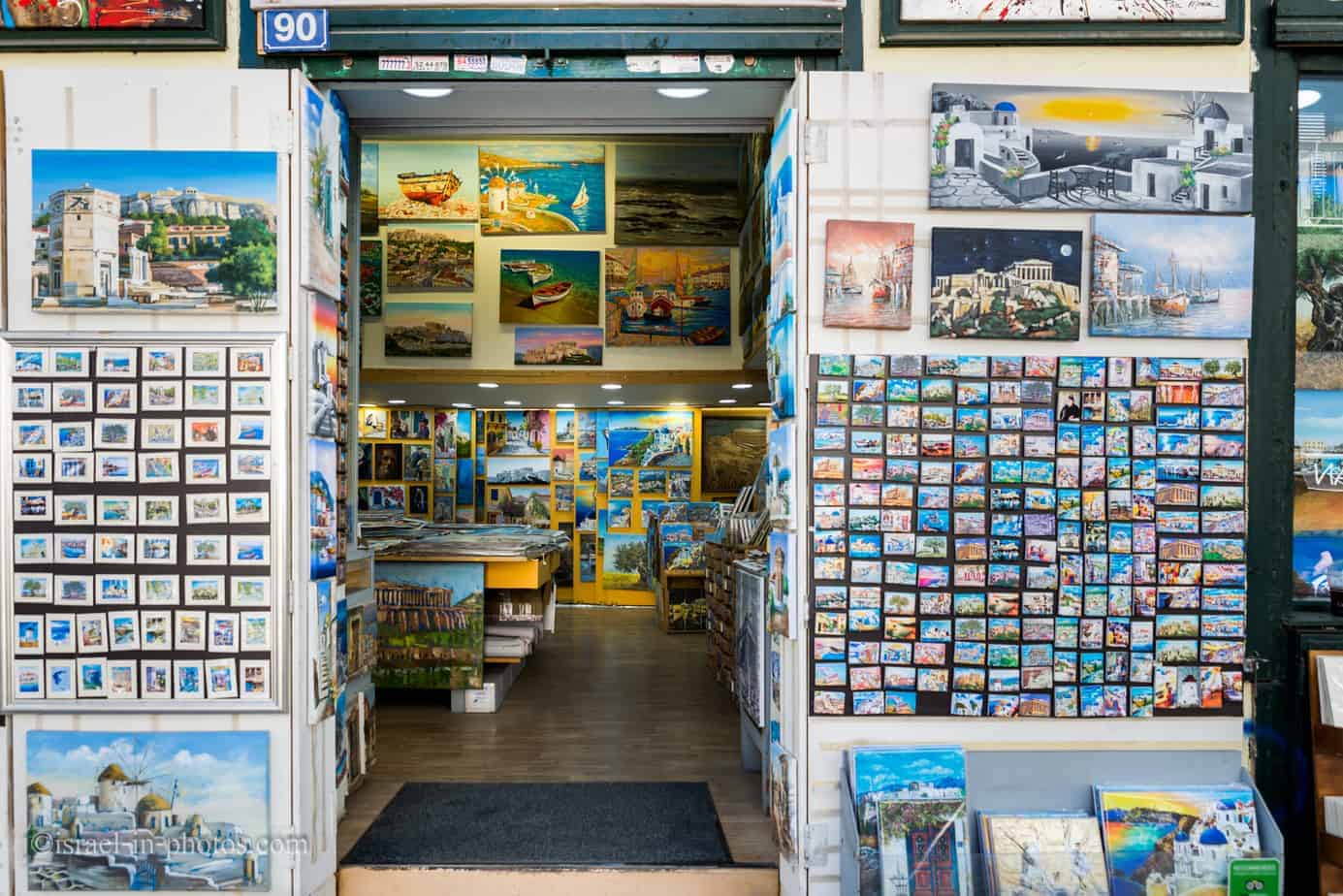
National Archaeological Museum
After lunch, we headed to the National Archaeological Museum. It is located further away from the city center (about 1.5 km from Monastiraki square), but we decided to walk there. And after nearly 20-minute walk we got there.
As you can see from the map, the National Archaeological Museum is housed in a three-floor building, and it covers only about a floor and a half.
Ground Floor
Ceramic ‘frying pan’ from the Early Cycladic period. The spirals represent foaming waves, and if you take a closer view, you will also notice a ship without a sail.
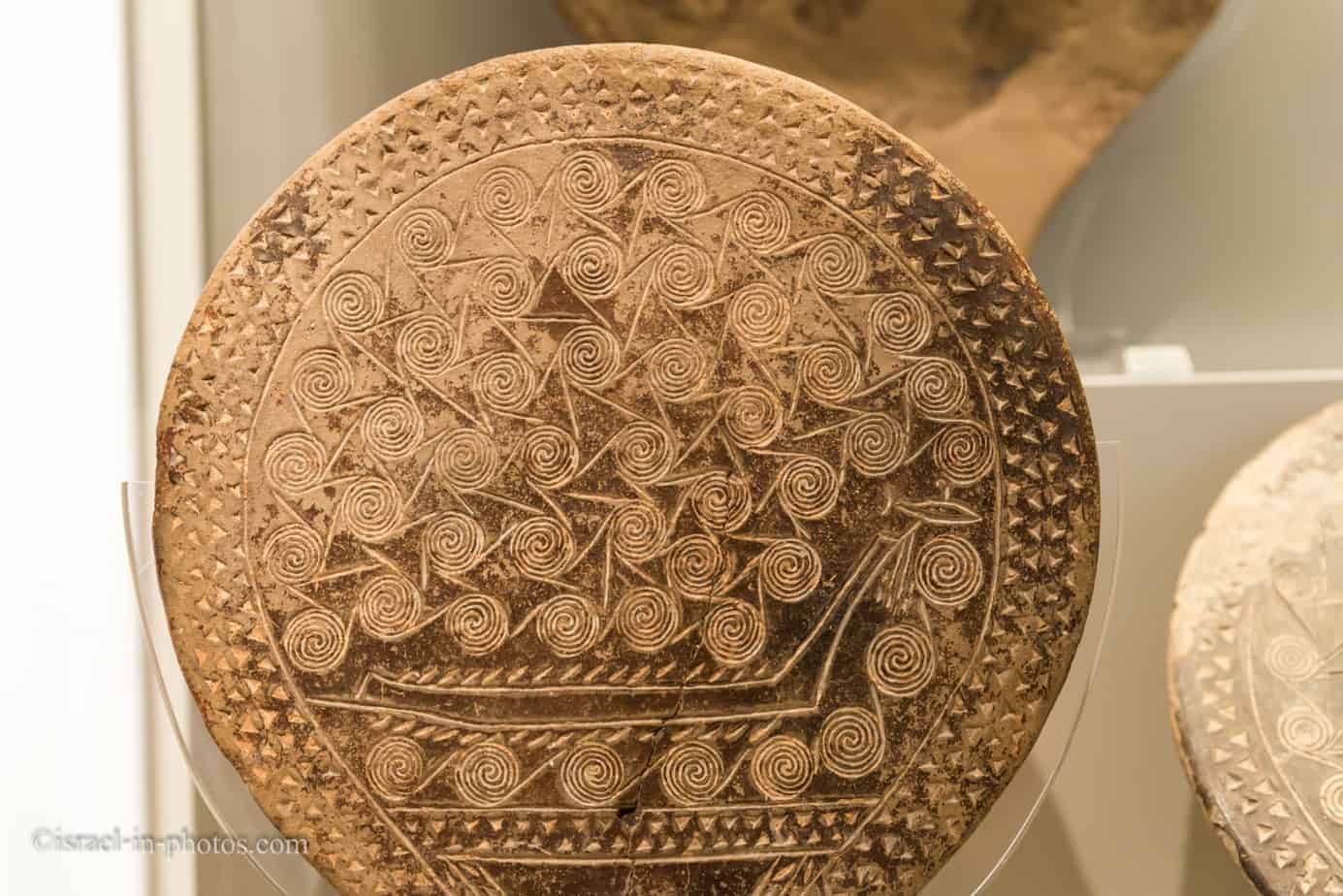
On the third day of the Greece trip, we visited Archaeological Site Mycenae. There are some of the treasures from Grave Circle A.
The original Mask of Agamemnon: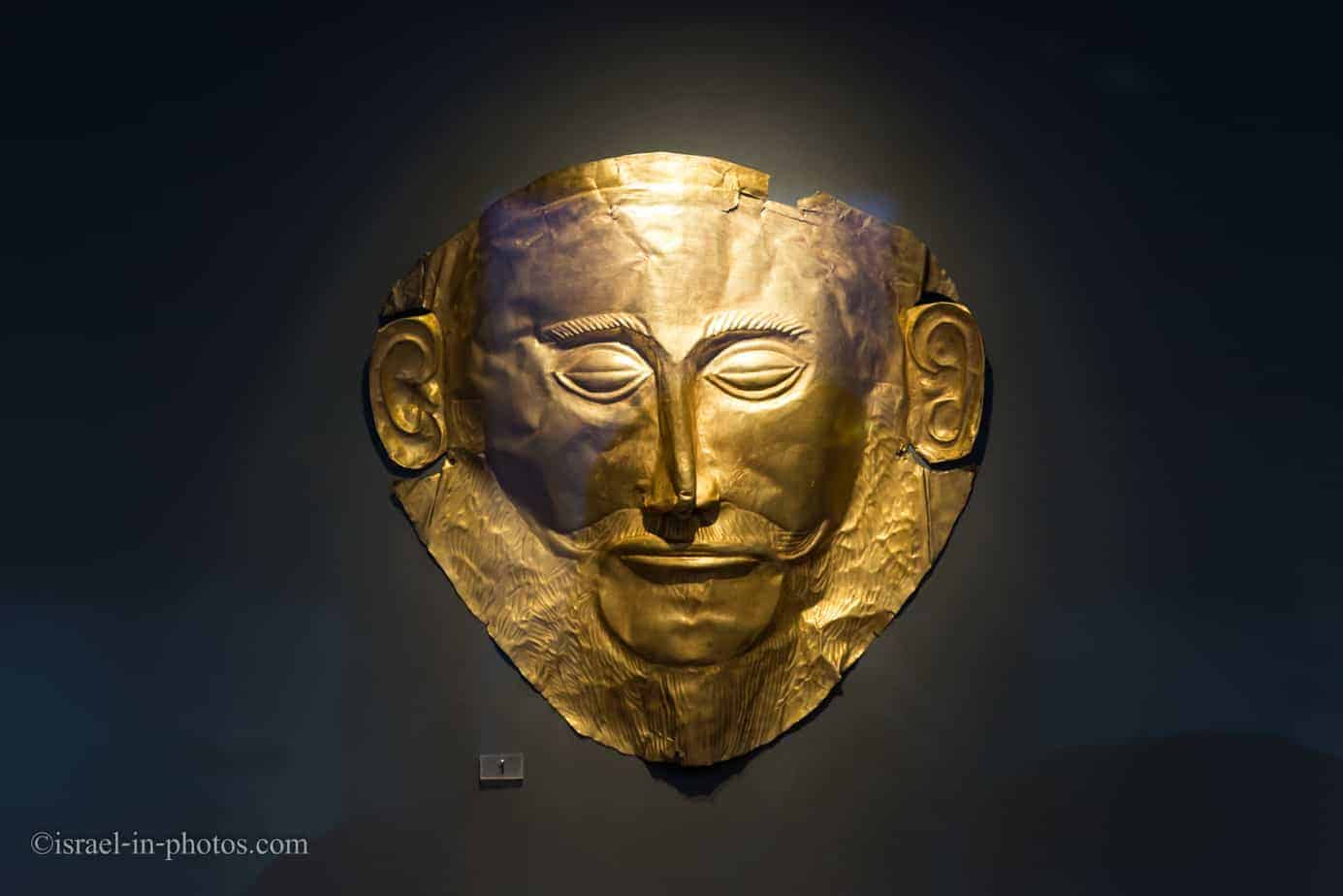
One of my favorite pieces was this bronze statue of a horse and a young jockey.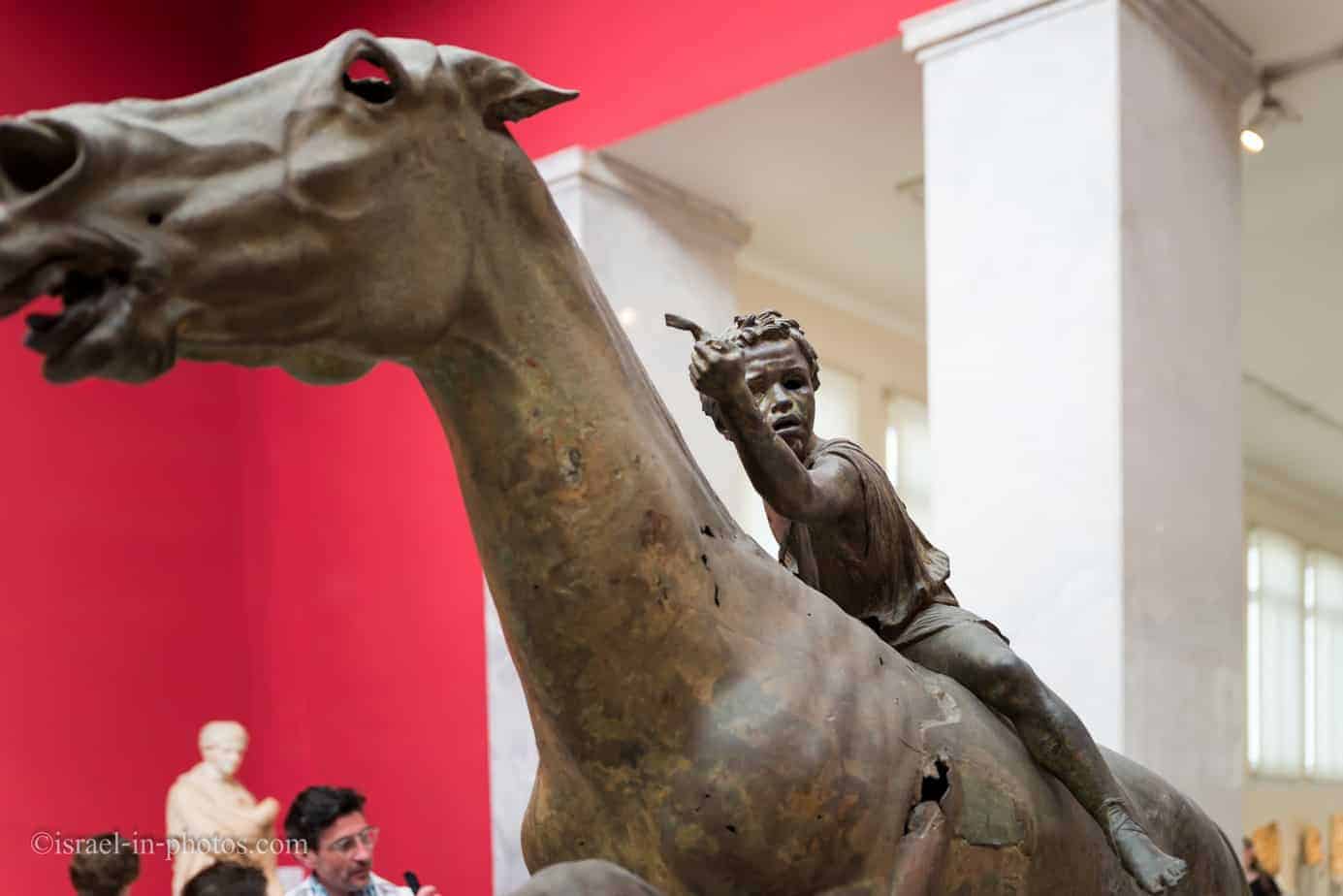
This statue from 150–140 BC was retrieved from the shipwreck in 1928. The reins from the left hand and a whip from the right arm were lost. This work is known as “Artemision Jokey.”
There is a small garden with sculptures, a cafeteria, and restrooms in the basement. After an ice cream break, cause it is impossible to visit the National Archaeological Museum with a child without some treat, we continued to the first floor.
First Floor
On the first floor, there are two spaces. There is the Thera room, and vases, and minor art collection. We started with the latter.
When looking closer at some vases, you realize they were glued from hundreds of parts. The amount of work to recreate each vessel was enormous.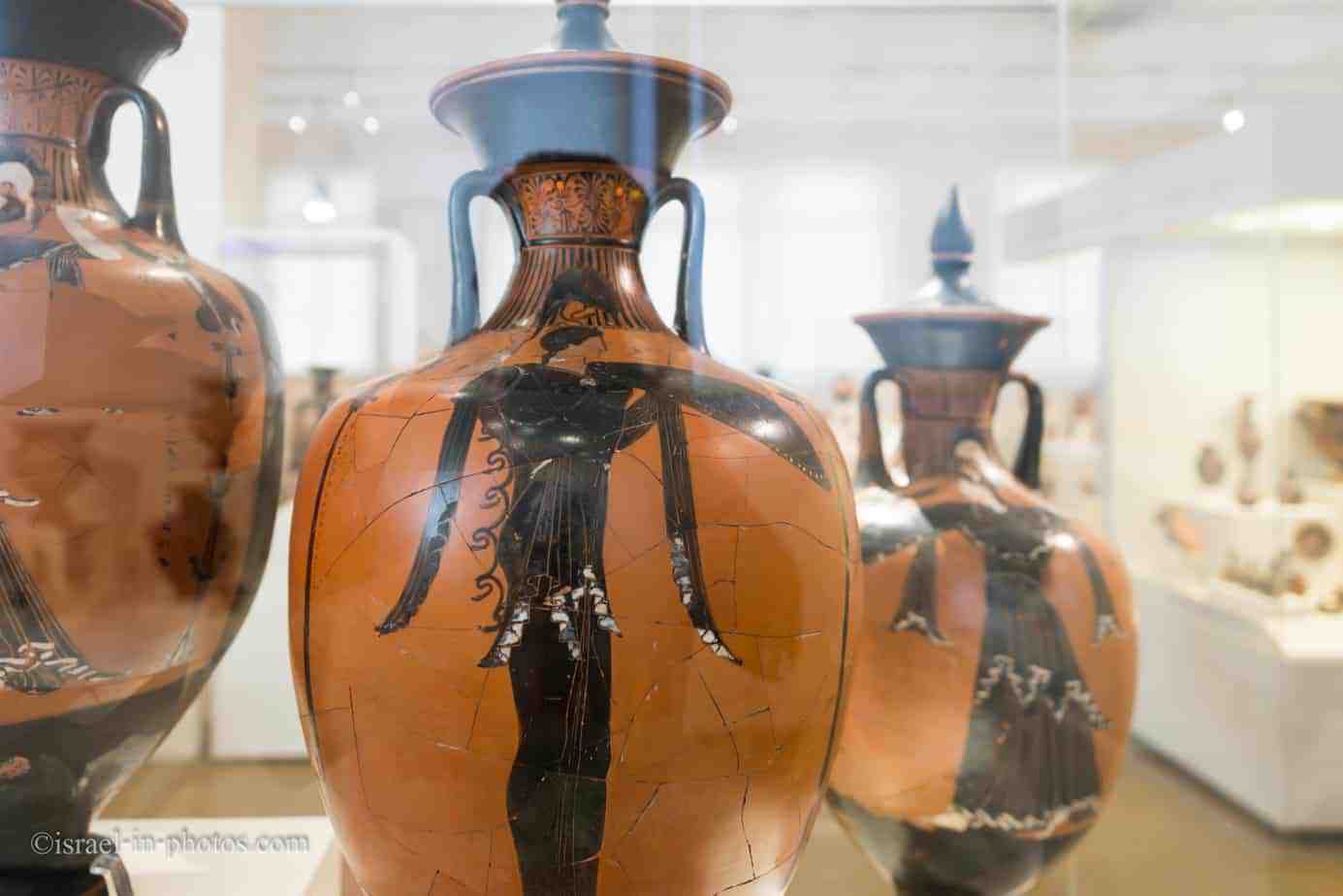
How many names of different vases do you know? I knew only several. Here is a list of 26 different vessel types.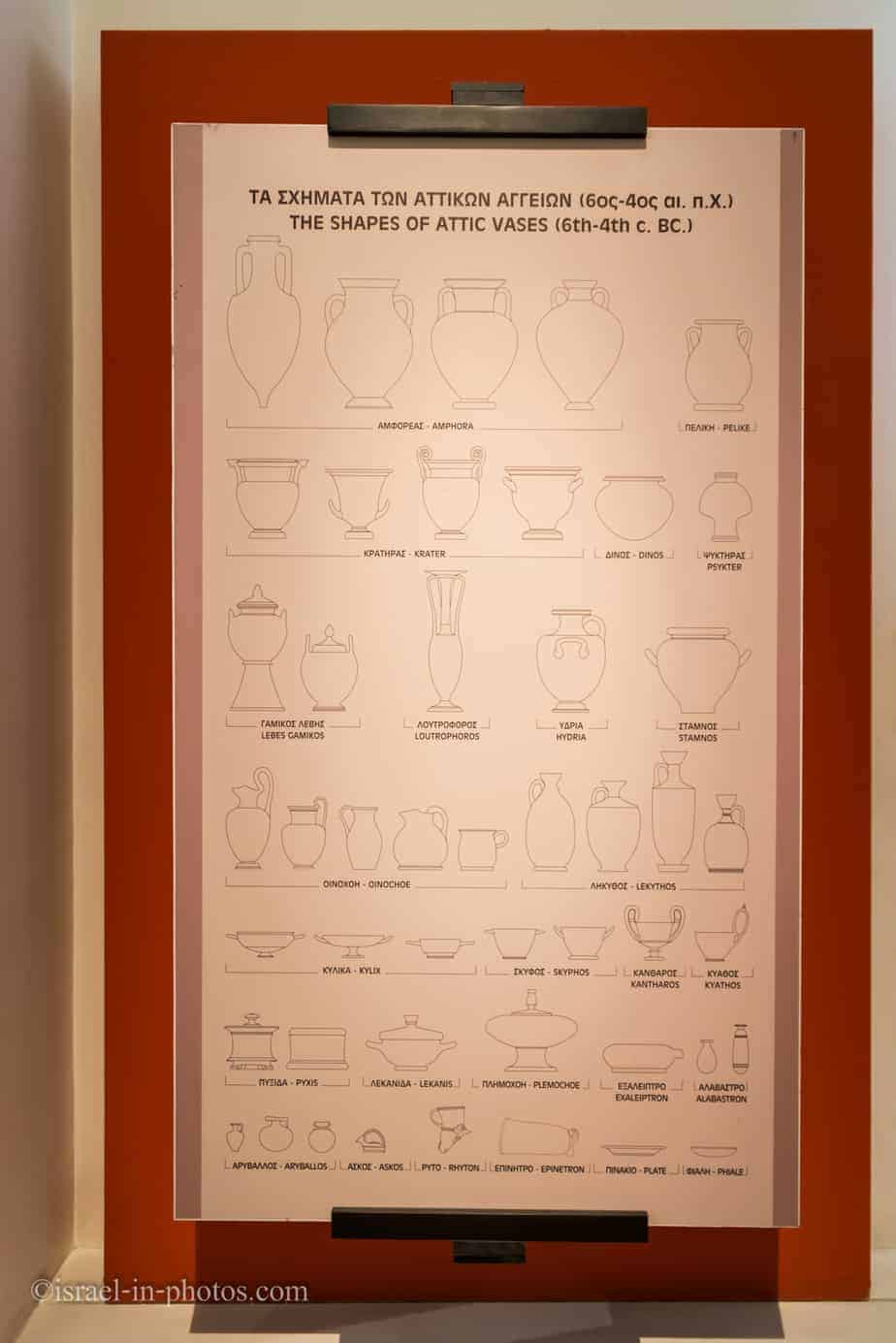
And we finished our visit to the National Archaeological Museum with the Thera room.
Thera is a Greek island not far from Crete. Akrotiri, a significant Bronze Age settlement, is located on the south coast of Thera. Evidence suggests human activity there during the fifth millennium BC. Later on, during the Early Bronze age to Late Cycladic (3 millennium BC – 16 century BC), Akrotiri was a prosperous settlement. Unfortunately, the settlement was destroyed in the Theran volcanic eruption sometime in the 16th century BC. It was buried in volcanic ash, which preserved the remains of fine frescoes and many objects and artworks. This exhibition presented some of the art, including several frescoes.
We were in the museum for approximately two hours. And during those two hours, we were able to cover the whole museum. I guess it is true what they say. If you want to see Greek archeology, go to London or Paris.
Day 3 – Ancient Agora of Athens and Kerameikos Archaeological Site
Ancient Agora of Athens
The following day we headed to the Athenian Agora. It is located below the Acropolis (you can see it at the top-right on the next photo) and not far from Monastiraki train station (you can also see the train). And the big columned building to the left is the Stoa of Attalos (located inside the park).

Diagram of how the Athenian Agora looked like:
It is the best-known example of an ancient Greek agora. But first, let’s answer the following question.
What is the Agora?
The Agora was a central public space in ancient Greek city-states. The word’s literal meaning is “gathering place” or “assembly.” The Agora was the center of the city’s athletic, artistic, spiritual, and political life.
Source: Wikipedia
As you can see from the diagram above, Athenian Agora was quite extensive, and today it is separated into several sites (this one called Athenian Agora, Kerameikos (#30), the library of Hadrian (#14)). Each site has a different entrance, and you need to pay the entrance fee at each place. I have not seen combined tickets, and as far as I remember entrance fee to each site was 8 Euro.
Temple of Hephaestus
We started our visit to the Agora with a walk towards the Temple of Hephaestus.
The Temple of Hephaestus or Hephaisteion, or earlier as the Theseion, is a well-preserved Greek temple. It remains standing almost as built. It is a Doric peripteral temple located on the northwest side of the Agora of Athens, on top of the Agoraios Kolonos hill. From the 7th century until 1834, it served as the Greek Orthodox church of Saint George Akamates. The building’s condition has been maintained due to its history of varied use.
Source: Wikipedia
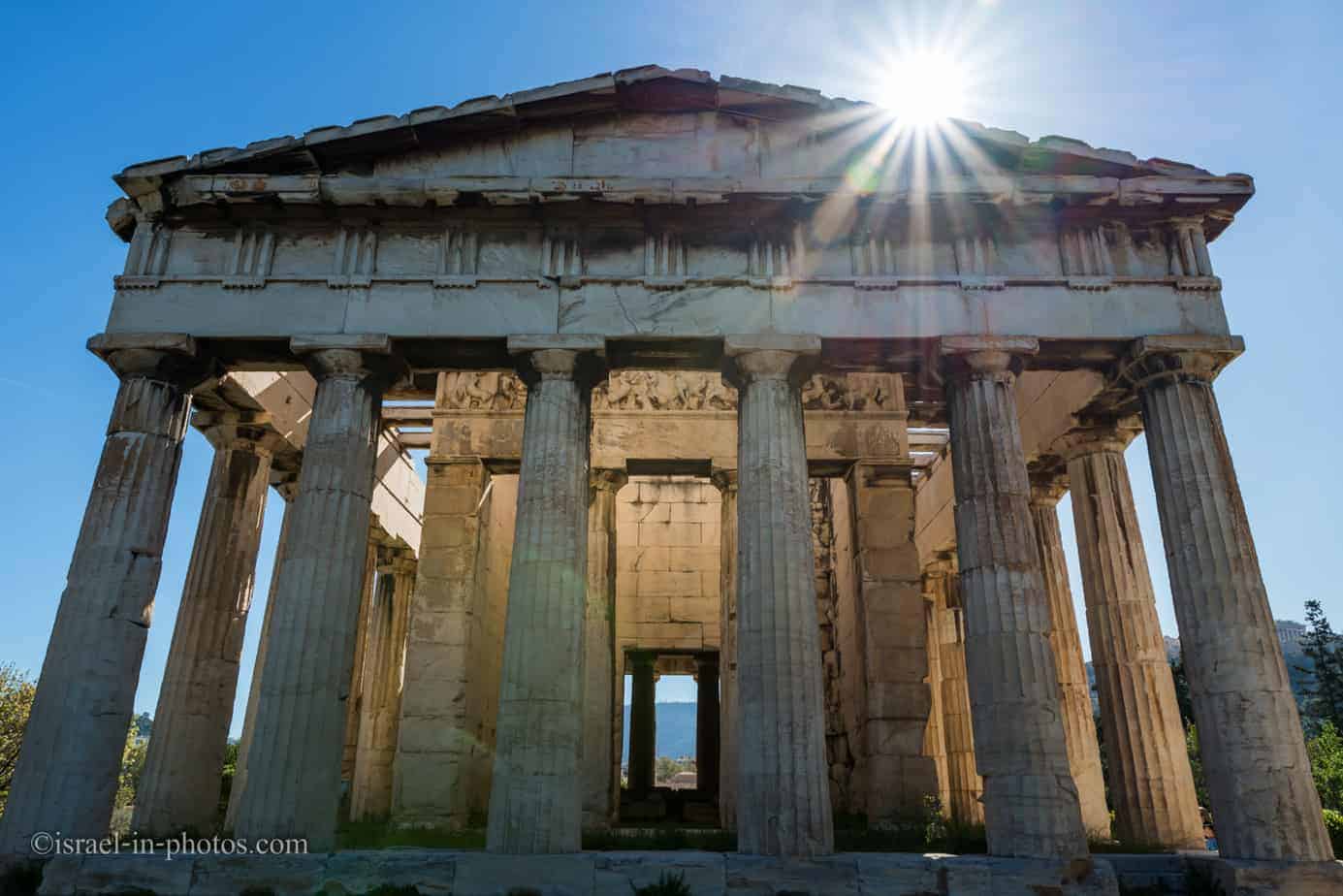
From the Temple of Hephaestus, we walked along the perimeter of the park until we reached the Church of the Holy Apostles.
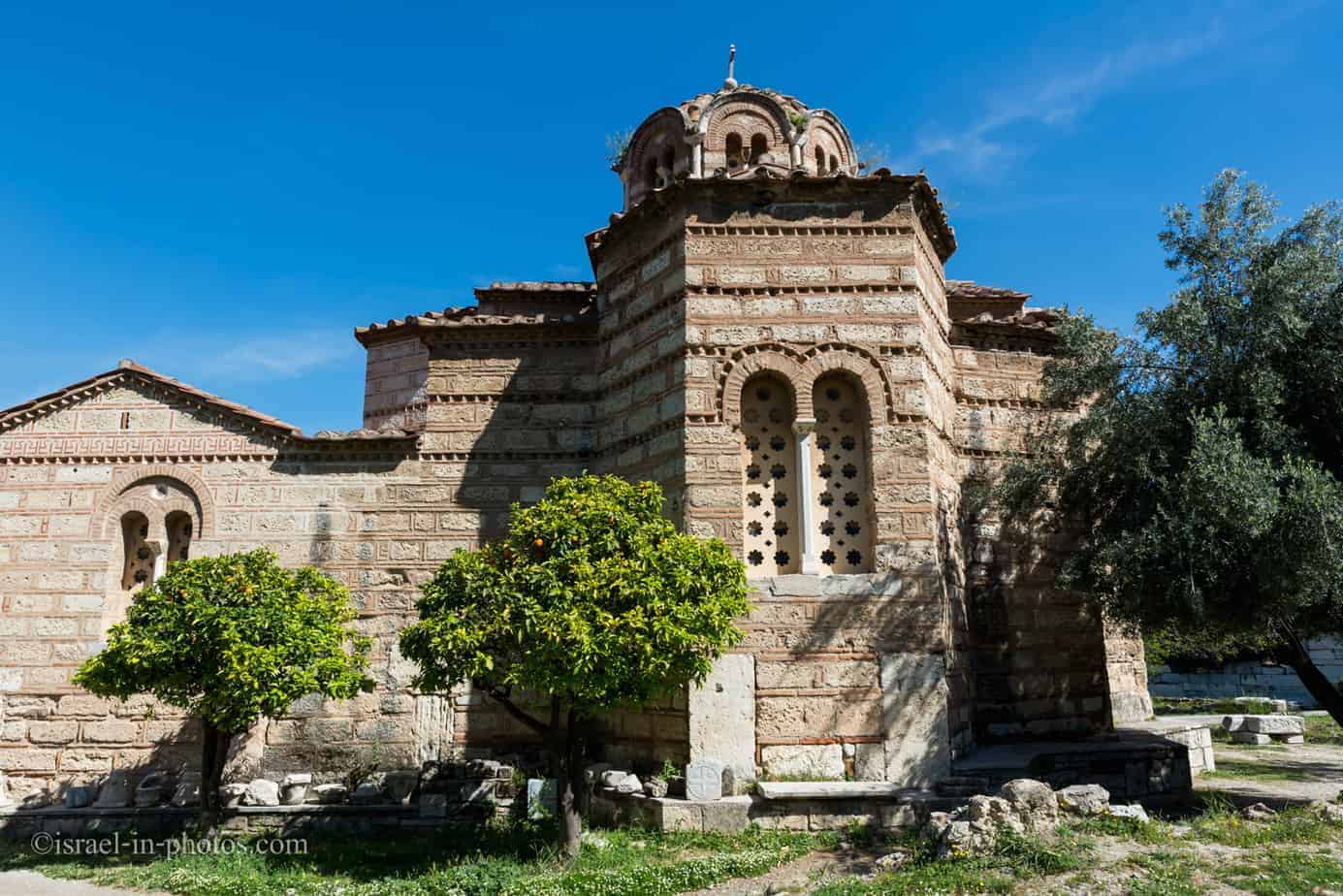

We continued exploring the Ancient Agora until we reached the Stoa of Attalos.
Stoa of Attalos
Stoa is a covered walkway or portico. This Stoa is named after King Attalos II of Pergamon, who ruled between 159 BC and 138 BC and built it.
Inside the Stoa of Attalos, there is a small museum.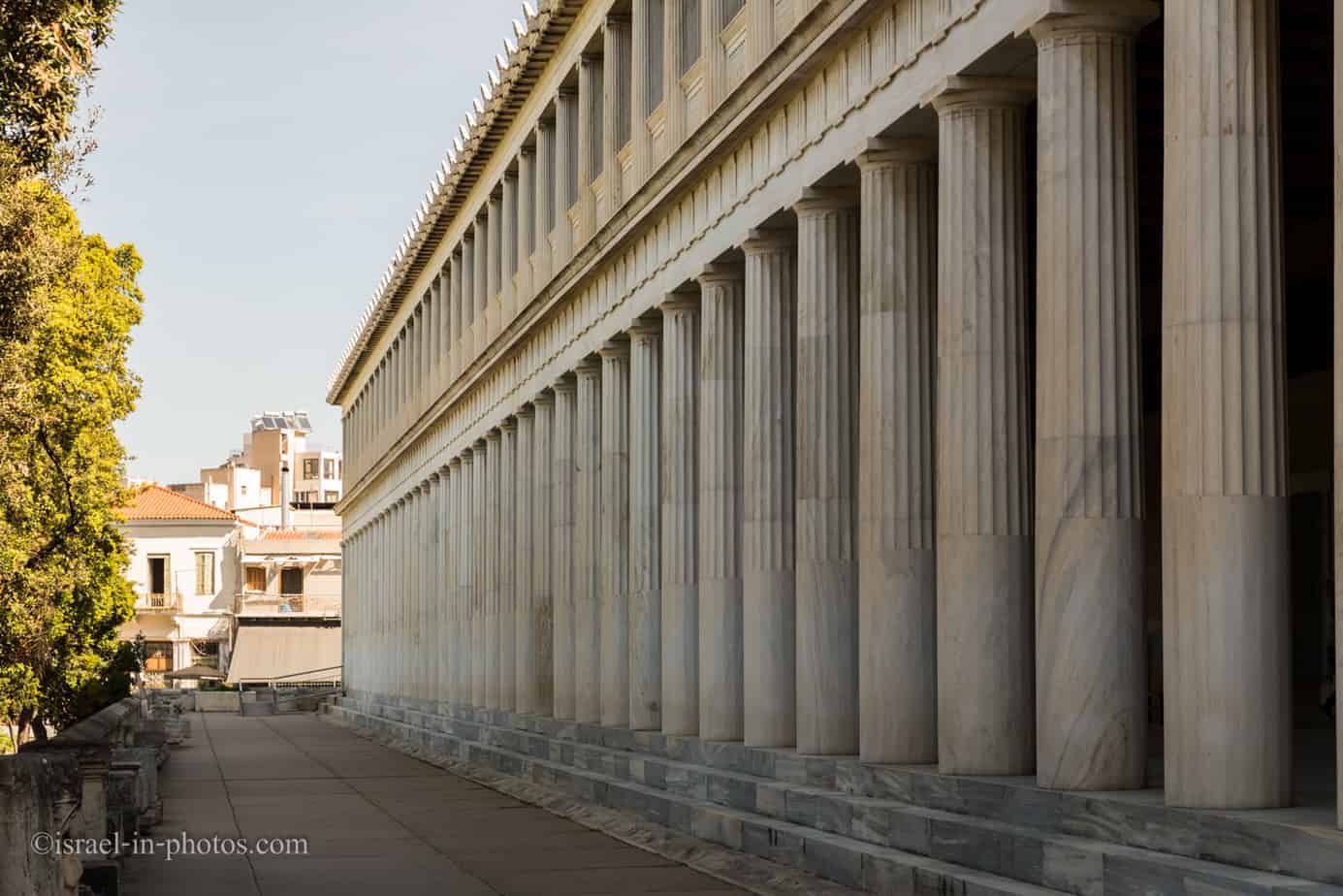
Inside the museum:
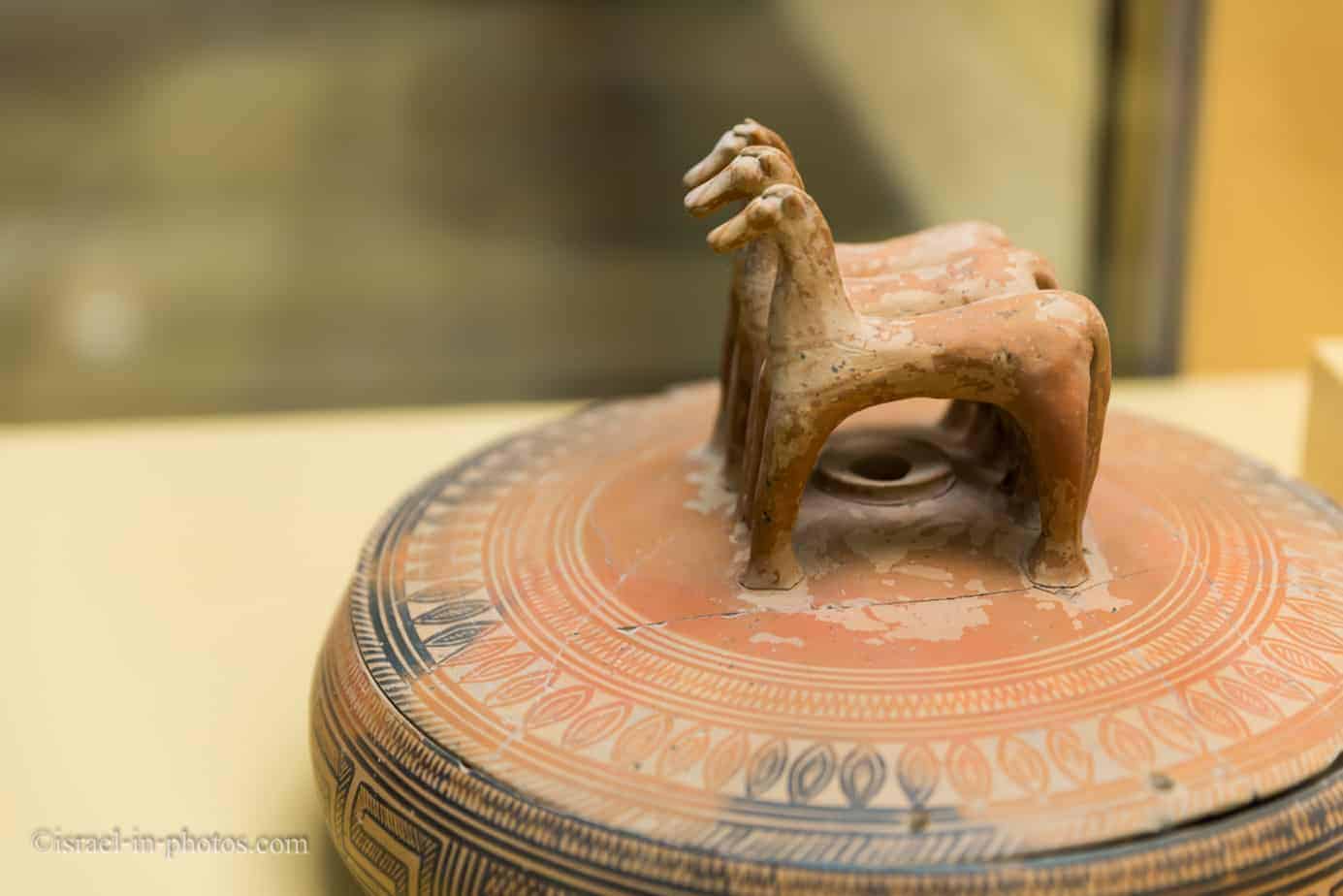
I was surprised when I saw this baby potty. I did not think people during that period already used it.
We spent about 1.5 hours at the Ancient Agora and headed towards National Observatory.
Filopappou Hill or Hill of the Muses
The National Observatory is located on top of Filopappou Hill. And on the way, we passed near the Church of St Marina in Thissio.

Thought did I check the opening hours at The National Observatory’s site (and it should have been open), it was closed. The guard told us the observatory was closed for Pascha. We continued climbing further to the top of Hill of the Muses, which turned out to be a good viewpoint. Here is a view of Acropolis from the top of Hill of the Muses.
While descending from the Hill of the Muses, a butterfly landed on my daughter’s head. It turns out that having a hat colored as flowers, had its advantages.
Our backup to the planetarium was Kerameikos.
Archaeological Site And Museum Of Kerameikos
Kerameikos is located close to the Ancient Agora we visited earlier. And if the name of this quarter sounds suspiciously similar to the word “ceramics,” then you are on the right track. Kerameikos was the potters’ quarter of the city. And the English word “ceramic” is derived from this name. Kerameikos was also the site of an important cemetery and numerous funerary sculptures erected along the road out of the city towards Eleusis.
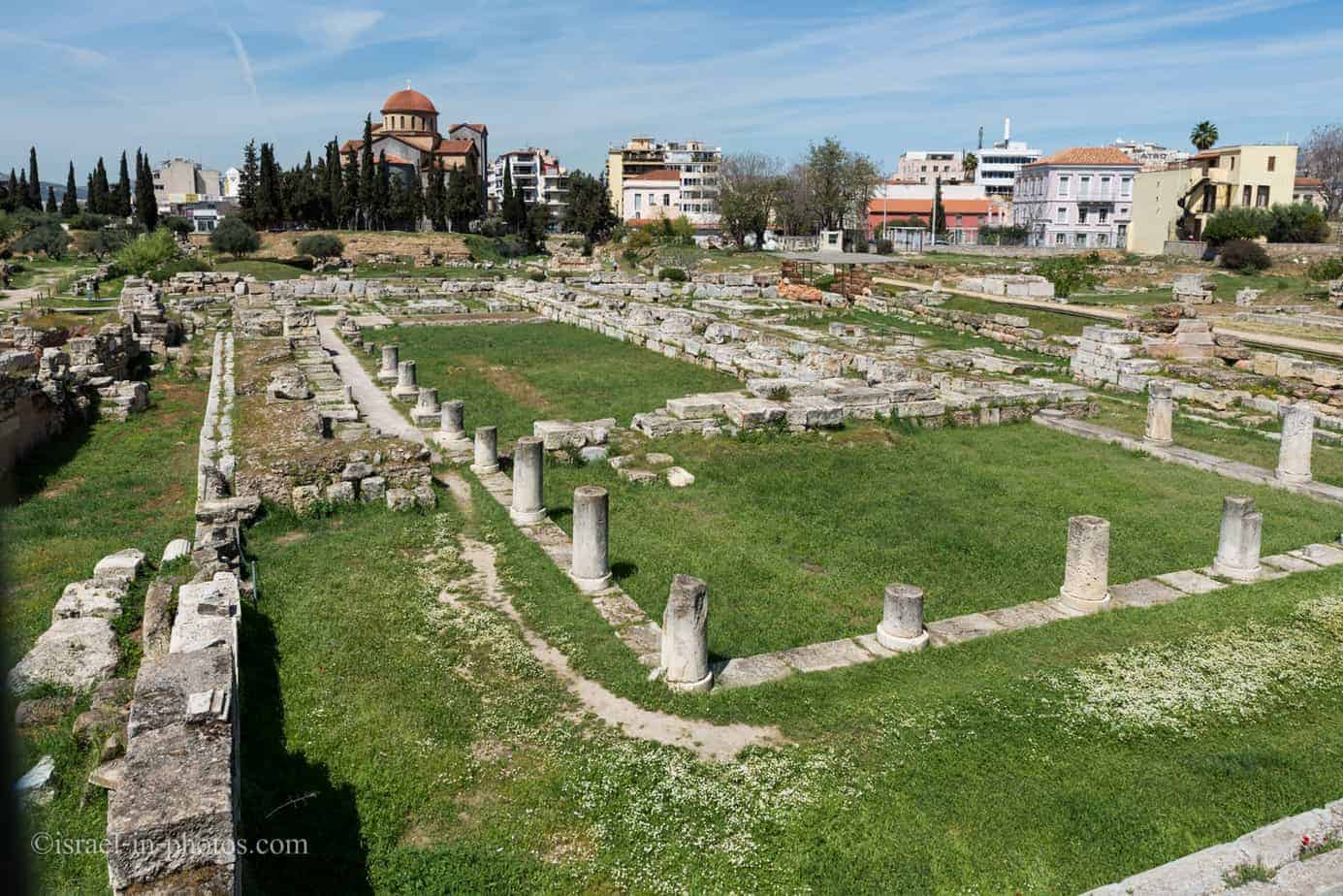
Kerameikos Archeological Site
We started by exploring the open area and soon reached the Street of Tombs.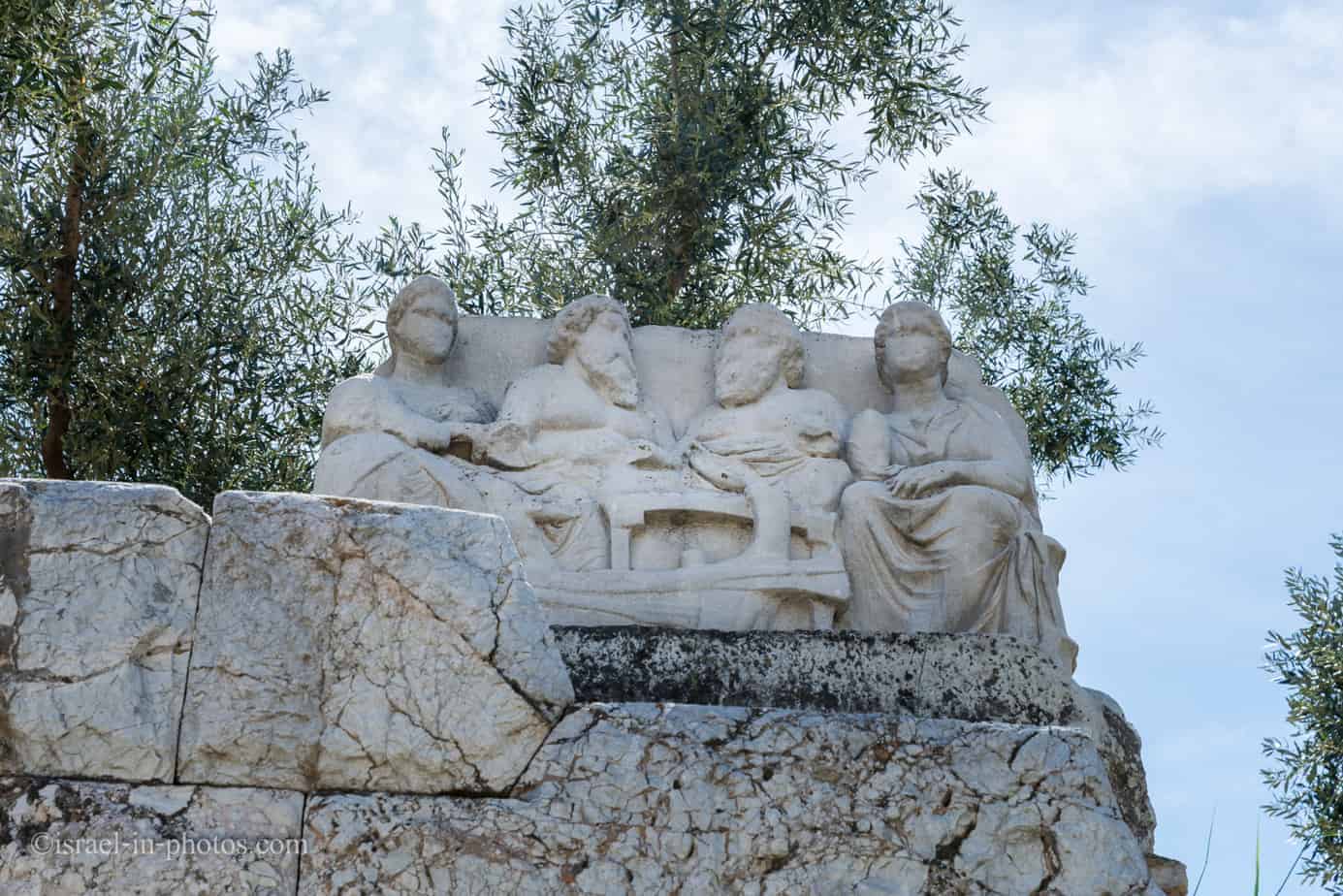
The Street of Tombs is a branch of the Sacred Way. And these are the best preserved and most luxurious funerary monuments of the 5th and 4th centuries BC.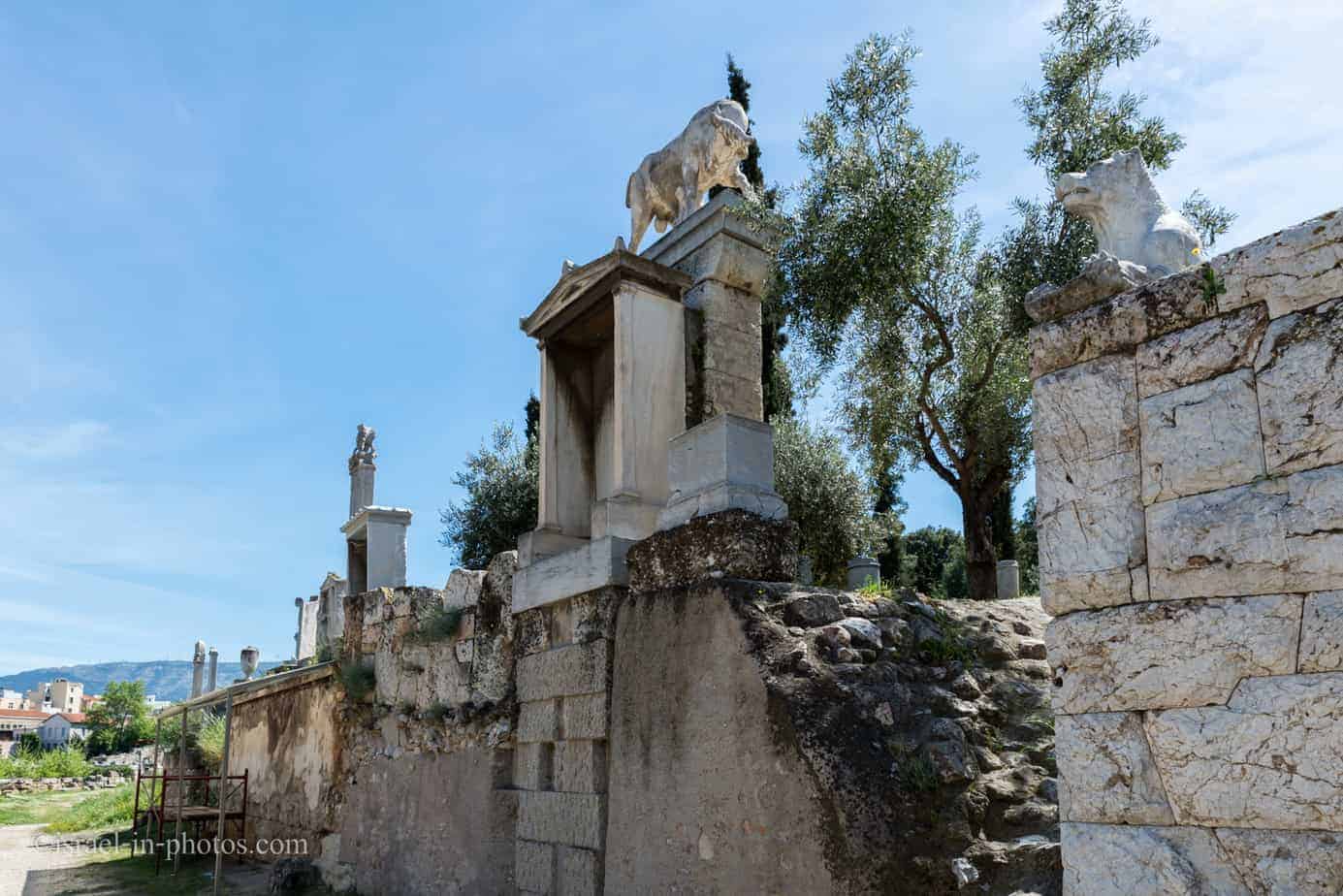
These reliefs and marble monuments belonged in general to family burial enclosures. It was how well-known wealthy Athenian families and foreigners preserved the memory of their glorious family members.
On a lighter note, here are some flowers 😉

Kerameikos includes an extensive area both within and outside the ancient city walls. It is crossed from North to South by the best-preserved fortification of ancient Athens. The overall perimeter of the wall was about 6,500 meters, and it had at least 13 gates. The two most important gates are at Kerameikos. They are the Dipylon and Sacred portals. The height of the wall was 7-8 meters, topped by towers. It was 2.5 meters wide and had a moat in front of it.
In 86 BC, the Roman army invaded Athens through the Kerameikos district and destroyed the wall. For three centuries, the wall was not used. And in 267 AD, following attacks of the barbarian tribe of the Herulians, Athenians repaired the wall once more. The last renovations of the fortification were made during the rule of the Justinian emperor (around 540 AD).
Kerameikos Museum
In the museum’s center, you can find the bull from the grave enclosure. The beast stood on a high pedestal in the middle of the graveyard. And in front of it, there was a tablet with carved epigrams and the deceased’s name. It said:
Dionysios, son of Alphinos, who died unmarried, lived in the deme of Kollytos, near Kerameikos, and on the island of Samos, where he served as treasurer of the Heraion for the year 346/5 BC.
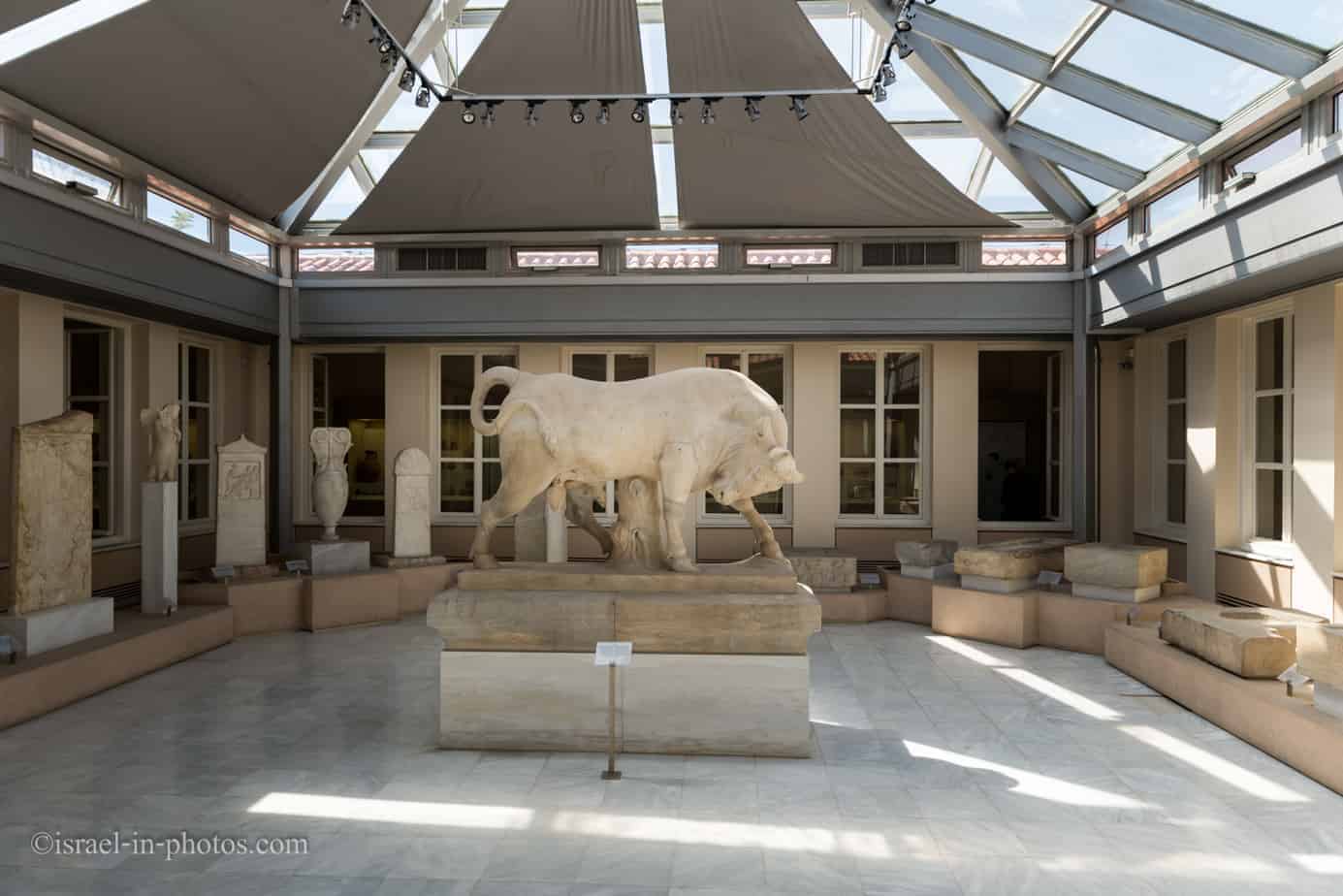
Ceramics form:
We spent about 1.5 hours at the archeological site and museum of Kerameikos and then headed for lunch at Monastiraki. 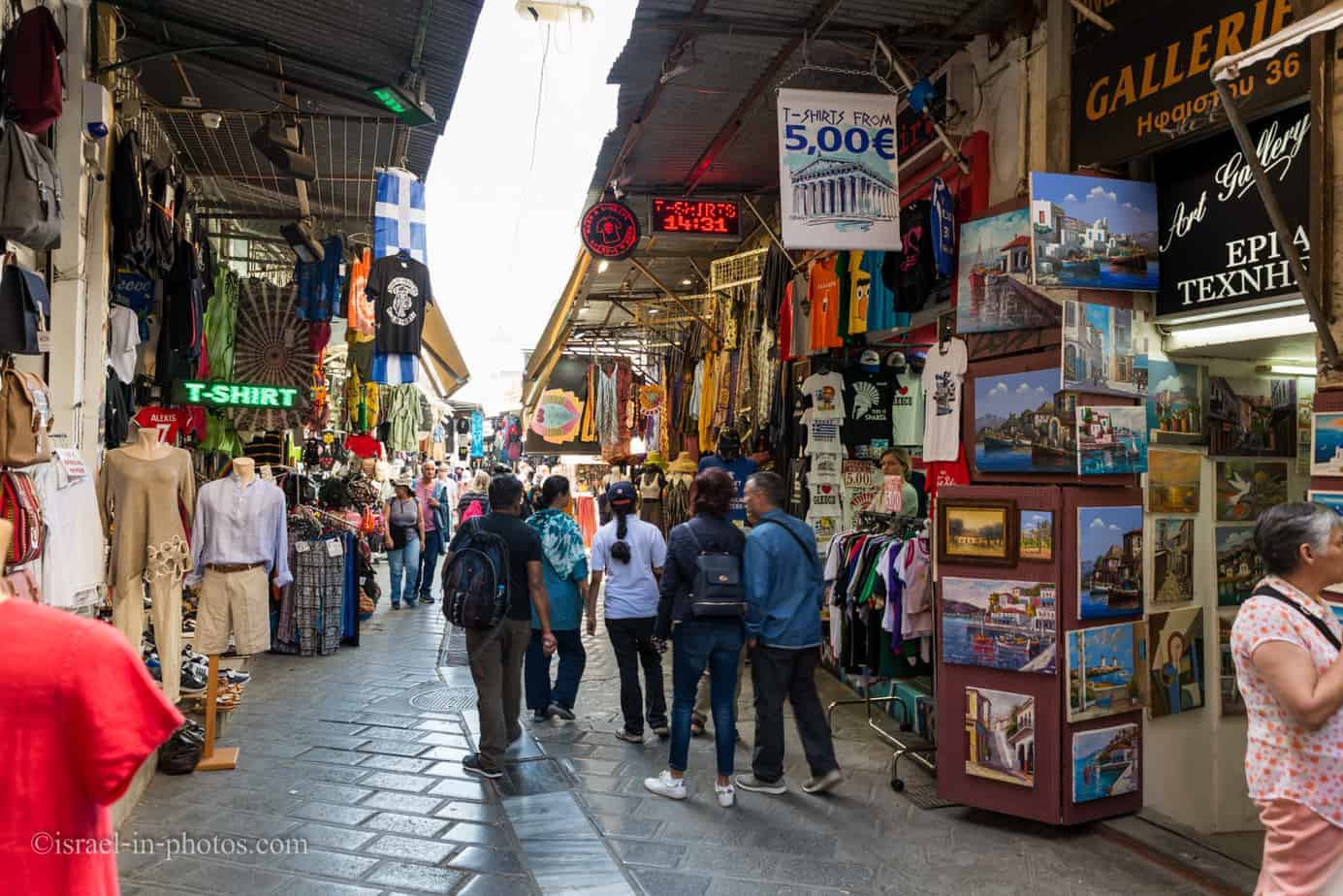
We had gyros, one of the more popular street foods in Athens, at the market. It was fresh, tasty and not expensive. And for desserts, we headed for a special place.
Hans & Gretel
Hans & Gretel is a sweets shop. You can buy there all kinds of desserts. And the main differentiating point of this store is its design.
They took the Hans & Gretel fairytale and made a designed candy store. They even built a small house from sweets inside the store.
We bought ice cream and ate it inside the hut. It was a fun experience, and if you are visiting Athens with children, consider stopping here.

If you would like to visit, Hans & Gretel is located at Adrianou 48.
Anafiotika
After a short rest at the hotel, we decided to go for an evening walk at Anafiotika. Anafiotika is a picturesque and tiny neighborhood on the northeast side of the Acropolis hill. You can find many charming alleys with classical architecture and, of course, graffiti. Here is an example:
We walked through this neighborhood until we reached Hadrian’s Arch.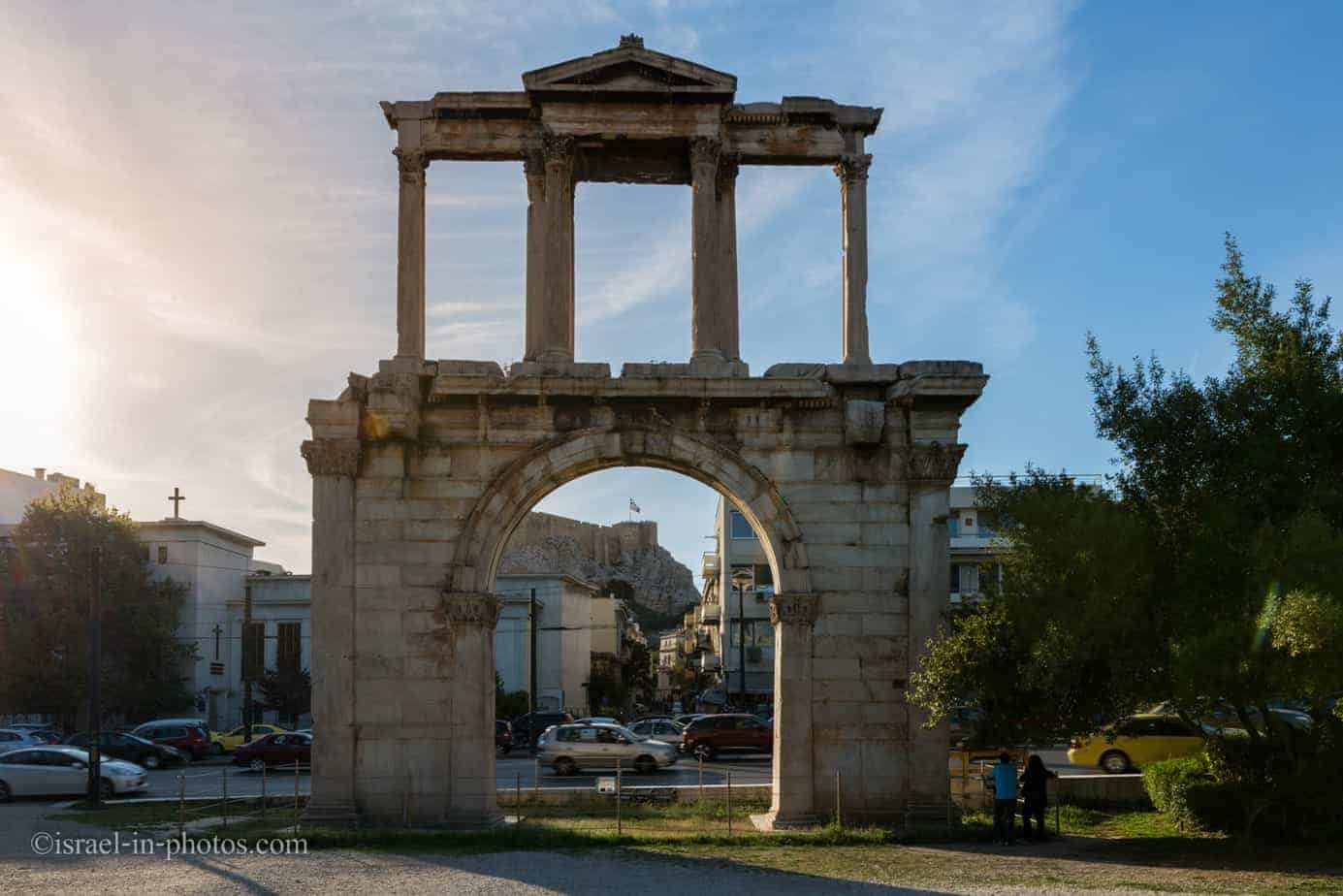
Hadrian’s Arch
Hadrian’s Gate is a monumental gateway resembling – in some respects – a Roman triumphal arch. It spanned an ancient road from the center of Athens, Greece, to the complex of structures on the city’s eastern side that included the Temple of Olympian Zeus. Some researchers proposed that the arch was built to celebrate the arrival of the Roman Emperor Hadrian and to honor him for his many benefactions to the city on the occasion of the dedication of the nearby temple complex in 131 or 132 AD. We are not sure who commissioned the arch, although it is probable that the citizens of Athens or another Greek group were responsible for its construction and design. There were two inscriptions on the arch, facing in opposite directions, naming both Theseus and Hadrian as founders of Athens.
Source: Wikipedia
And on our way back we passed near St. Catherine’s Greek Orthodox Byzantine Church.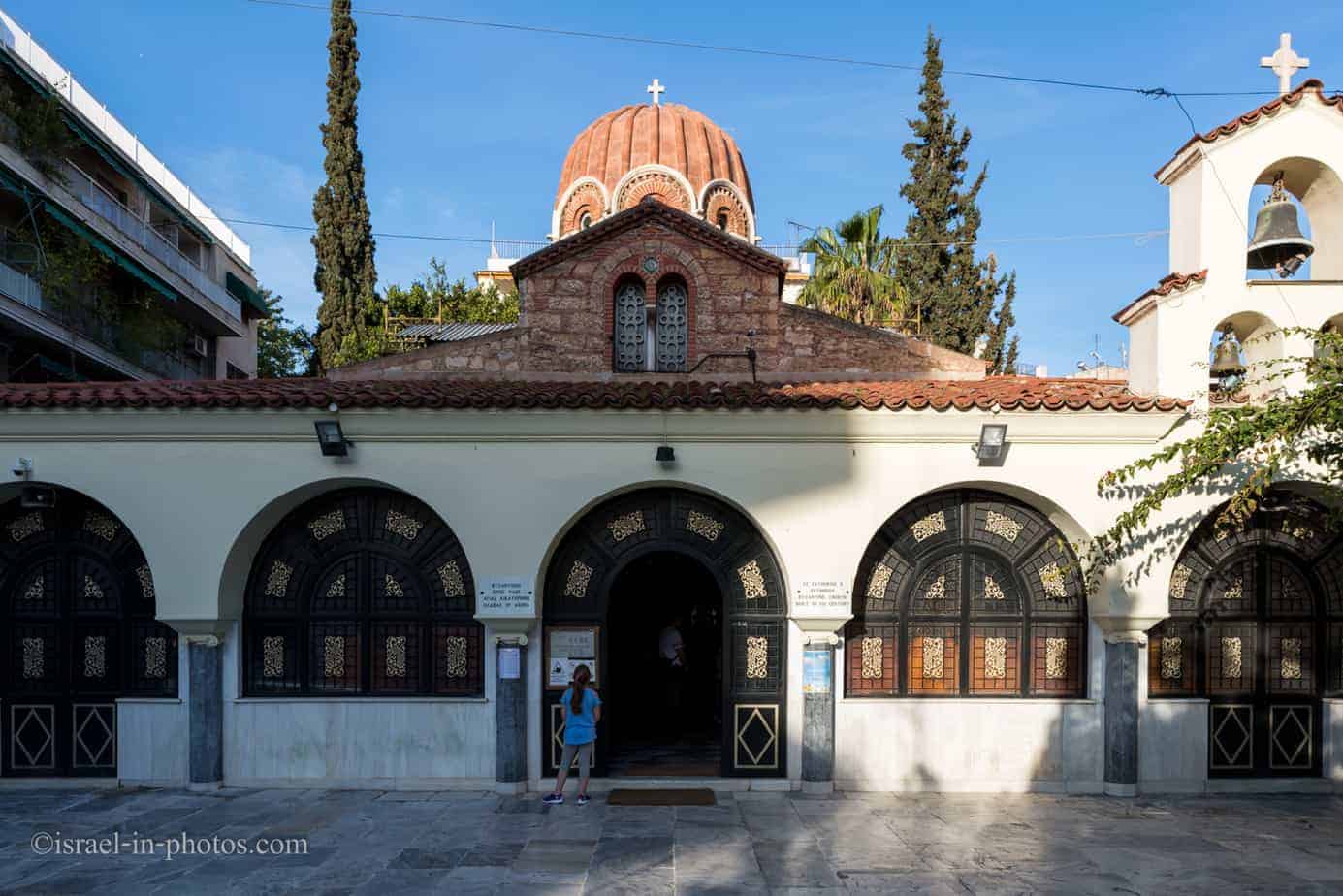
Plaka is a nice neighborhood to stroll around, eat, and buy souvenirs.
I took this shot after dinner near our hotel, and as you can see some places take their design to the next level.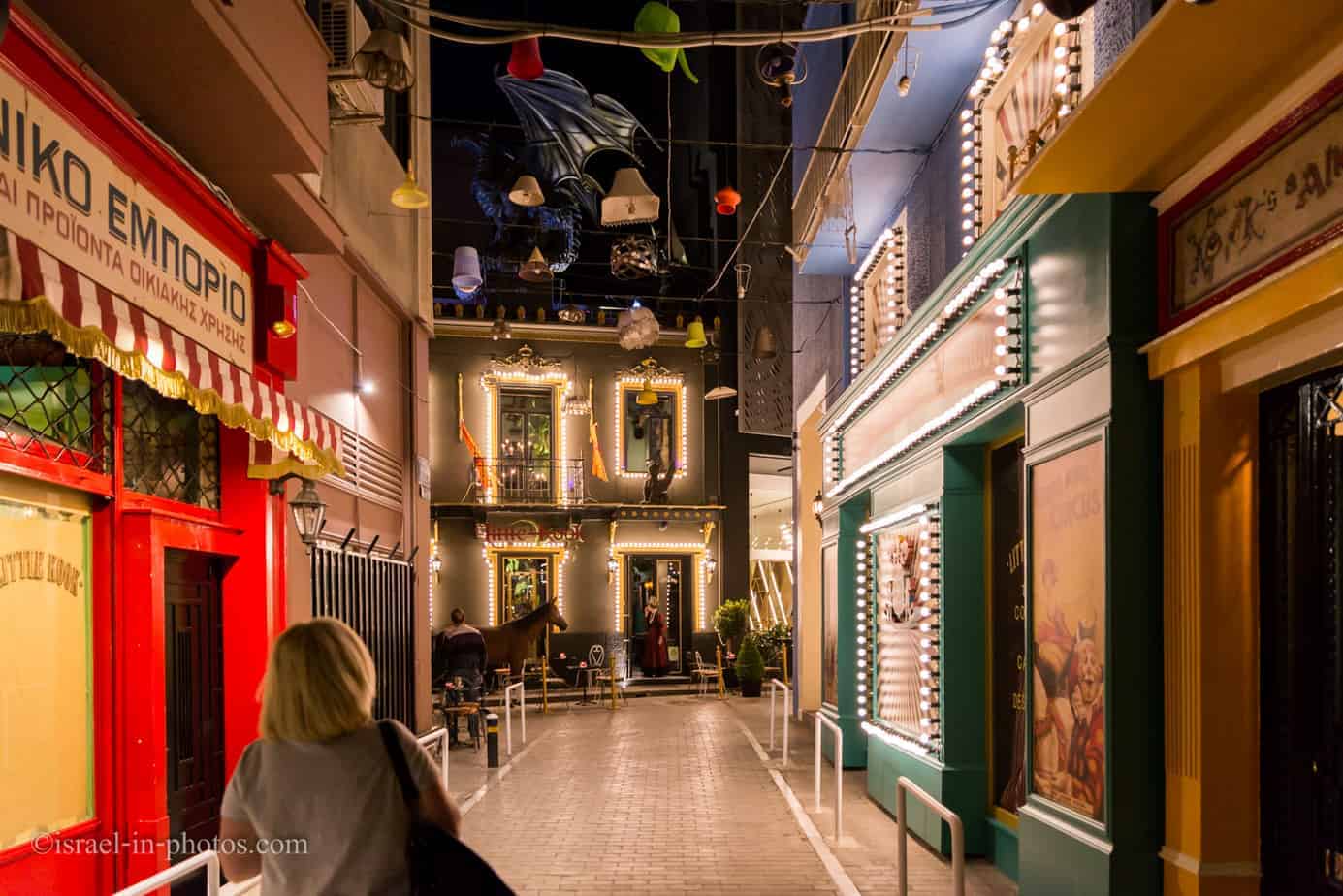
Day 4 – Roman Forum
It was our last day in Greece, and we had time till noon. Thus, we decided not to visit any unique attraction and mingle with the locals (well, more likely it was with other tourists). So we wandered at Plaka and Monastiraki.
We passed near the Roman Forum several times during the last days, but we walked next to its other part this time. And we saw The Horologion of Andronikos Of Kyrrhos. This unique structure drew our attention, and we found a nearby board. It is the world’s first meteorological station.
The Tower of the Winds or the Horologion of Andronikos Kyrrhestes is an octagonal Pentelic marble clocktower in the Roman Agora in Athens that functioned as an horologion or “timepiece.” It is considered the world’s first meteorological station. Unofficially, the monument is also called Aerides, which means Winds. The structure features a combination of sundials, a water clock, and a wind vane. It was supposedly built by Andronicus of Cyrrhus around 50 BC. But according to other sources, might have been constructed in the 2nd century BC before the rest of the forum.
Source: Wikipedia
Our time is up, and I will finish this post with a photo of an alley in Anafiotika.
Summary
Athens left us with a mixed feeling. The main reason for that is that we enjoyed it less than the rest of Greece. I will start with the main downsides. First of all, the city is very touristic and thus loses the “personal touch.” Secondly, the cleanliness is poor, and when you leave the tourist areas, you do not feel safe. Maybe it is just my impression following broken windows theory, but the vibes we got when we walked to the National Archaeological Museum were not favorable. Thirdly, as you saw, most sites are relatively small. Not much is left, and the duration of an average visit to a museum or an archeological site is 1.5 hours. And the last point, though it is less critical, you still need to consider that Athens is more expensive than the rest of Greece.
On the opposite side, Athens has a lot of attractions to offer (and we even have not covered all the tourist ones). Moreover, you can spend a week there (but a typical visit will probably be 1 – 3 days). Furthermore, most attractions are nearby, and you can explore the city on foot. The people were friendly, and the food was excellent. Therefore I would recommend visiting Athens. Maybe, make some adjustments after reading this post, and you will be ready to go.
Have you ever been to Athens? Tell us about your experience in the comments below.
That’s all for today, and I’ll see you in future travels!
Stay Tuned!
Additional Resources
Here are several resources that I created to help travelers:
- Trip Planner with Attractions and Itineraries is the page that will help you create your perfect travel route.
- What is the Best Time to visit Israel? To answer this question, we will consider the weather, prices, holidays, festivals, and more.
- Information and Tips for Tourists to Israel will answer the most common questions tourists have about Israel (including safety, passports, weather, currency, tipping, electricity, and much more).
- Israel National Parks and Nature Reserves include a complete list, top ten, map, tickets (Israel Pass, Matmon, combo), and campsites.
- If you are looking for things to do, here are the pages for Jerusalem, Tel Aviv, Haifa, Sea Of Galilee, Akko (Acre), Eilat, Nazareth, Safed (Tzfat), and Makhtesh Ramon.

